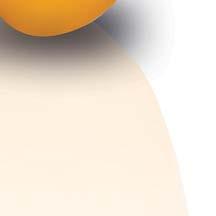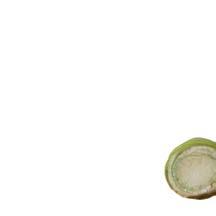CREATE A HEALTHIER FUTURE

The right tools for the job, comprehensive





WHAT
A

60 Making work in horticulture safer










A

60 Making work in horticulture safer



had told him they wanted he would have bred a faster horse! So many people have worked very hard to develop a horticulture strategy that will focus our efforts and energies to the future opportunities to enable us to succeed.
Horticulture New Zealand has been actively lobbying political parties to adopt policies that will support growers doing what they do best –put simply being able to grow! What keeps New Zealand’s fruit and vegetable growers awake at night? is our manifesto policy document which if you haven’t seen is on our website and which presents key issues of our 4,200 grower members who grow over 100 different types of fruit and vegetables which are consumed domestically or exported to over 100 countries around the world.
Our main call has been for the next government to give horticulture greater recognition and policy support, rather than it being a second or third cousin to pastoral and forestry activities. We are a $6 billion sector and growing if government enables, to $12 billion under the Aotearoa Horticulture Action Plan, and yet governments have given their primary focus and efforts to dairy and meat farming.
As Henry Ford once famously said, if you always do what you have always done, you will always get what you always got – he also said if he had followed what many people
The Aotearoa Horticulture Action Plan is now finalised and is in the process of being implemented and it is something that we have pushed strongly to all political parties, as how we can all focus our collective efforts, industry, government, science, and Māori, to deliver what will make the biggest difference to growers in New Zealand.
We have some huge challenges ahead, whether that be increased resilience against climate change, or improved and ongoing certainty to be able to access water, or available and affordable labour, and these are all some of the key themes in the plan that we have been advocating for. It’s reassuring that a number of political parties have supported the approach, at least that’s what they are currently saying!
Horticulture New Zealand also been going through a significant transformation over the past three years, making it a more effective and focused organisation that in today’s world can better advocate for our grower members. Advocating in today’s political environment where populist policies are rife, is both more difficult and very different than what it used to be.
I have been on the horticulture board since 2012, and my assessment of the change that has happened over

that time has been we were initially a ‘good’ organisation, saying yes when asked to do things so we kept everyone happy. In the more recent years as the intensity and complexity of work has increased, we didn’t always have the capacity to deliver, and our role was so broad it was really hard for even us to define! We needed to develop a more sustainable and focused operating model.
The organisation has significantly transformed over the last three years especially under the leadership of our current chief executive, and fully supported by the board, to understand how we can be most effective in advocacy. Along with clarity with what our role is, and as importantly what it isn’t, and then with a new structure to support staff to succeed in their roles. In the process we have brought into HortNZ staff with new skills and experiences, so we are best able to deliver what is required for growers in today’s Aotearoa New Zealand.
As I write this, we are soon to go to the polls to determine who will lead our country for the next three years, and I really hope we elect the best team, as New Zealand certainly has some challenges currently and ahead to overcome!
4,200 GROWER MEMBERS OVER 100 DIFFERENT TYPES OF FRUIT AND VEGETABLES
That has also resulted in HortNZ increasing its capability into areas such as labour availability and environmental policy settings, and pan-sector risk policy, while decreasing its role in others, such as with specific product market access and specific product biosecurity activities, areas where product groups have taken leadership.
Change is not without its challenges, and in this case in the process of transformation we lost some staff who decided to move to new roles outside of HortNZ after being with us for some years. Always sad when this happens, but this is often part of transformation, and I recognise and acknowledge these are people who have done terrific work in their time with us for horticulture and for growers, and we wish them all the very best in their new jobs.
But also and excitedly, we have recruited people with new skills and experience, and suited to how the organisation in today’s world needs to work to be both successful while working sustainably.
We have for some time been suggesting better ways of collaboration with product groups and district associations that is definitely needed, and which we are committed to making happen. What I saw when coming on the board was multiple organisations that were not sure of what their roles were, with everyone wanting to do everything, which ended up with lots of duplication and inefficiencies, and even at times competing with each other. Everyone I assume was seeing the need to tell their members they had done the ‘work’, so their members would continue to support, but now we
need to show leadership our members expect and put the efforts collectively into finding ways that we are fully aligned and working together, without duplication.
Advocating in these times is tough, with some enormous issues like climate change and with influential people and groups arguing for exactly the opposite outcomes that we may want, so we must be able, nimble, resilient and connected, presenting as one if we are going to succeed. All organisations need to modernise and keep both fit for purpose and relevant, and that’s exactly what HortNZ has done.
I wish the new government all the very best in leading our country, especially in caring for our people and protecting what we have, while setting policies that will be business friendly and enable growth.
It’s a tough gig with all the competing issues and needs, but rest assured with horticulture we have an industry plan, and HortNZ has a new sense of purpose and energy that will see us knocking on your doors sooner rather than later to get action on the opportunities for horticulture that we know are real but that are not currently being enabled.
Kia kaha.Acting Editor: John Gauldie
Email: editor@hortnz.co.nz
Advertising Manager: Debbie Pascoe
Ph: 027 485 8562
Email: debbie.pascoe@hortnz.co.nz
Design:
Scenario Communications
Ph: 04 385 9766
Email: joy@scenario.co.nz
Subscriptions: Email: info@hortnz.co.nz
NZGrower is produced by Horticulture New Zealand and is free for all levy payers. The magazine is also supported by: Vegetables New Zealand Inc, Process Vegetables NZ, TomatoesNZ, Potatoes New Zealand Inc, Onions New Zealand Inc.
The individual comments and views in this magazine do not necessarily represent the view of Horticulture New Zealand.
ISSN: 2230-2700 (Print)
ISSN: 2744-5712 (Online)
This publication uses vegetable based inks and environmentally responsible paper produced from Forest Stewardship Council® (FSC®) certified, Mixed Source pulp from Responsible Sources.
Paper produced using Elemental Chlorine Free (ECF) and manufactured under the strict ISO14001 Environmental Management System.
The wrapper we use is 100% recyclable, it is LDPE 4 (Low Density Polyethylene) Soft Plastic and meets the required standards. For further information refer to: https://www.recycling.kiwi. nz/our-story
We are a $6 billion sector and growing if government enables, to $12 billion under the Aotearoa

As you read this column, the General Election will be days away. And no matter what the polls are showing, there will still be a lot of uncertainty about the outcome. Which minor party will be kingmaker, what disruption might play out and how quickly can we get on with firstly rebuilding our sector, and in doing so the New Zealand economy?
To have the confidence to make investment decisions, businesses need certainty. A lack of certainty around elections is one reason the share market and New Zealand dollar often dip around election time.
The lead-up to the election has been characterised by an avalanche of promises in the shape of new initiatives and policies. The Finance Minister has announced government department spending cuts, by between one and two percent. While that doesn’t sound like much, it still represents hundreds of millions of dollars and creates a slowdown in the public service, and for our sector potentially support in the form of government funding.
Some would say the cuts are a positive thing, especially if it slows the tidal wave of regulatory change we have been enduring for the last 12 months or more, changes that are now in the throes of being implemented with varying degrees of risk and complexity. But on the other hand, it could equally be a bad thing because of the complexity of those proposed changes. Not only that we could lose the very people who developed these complex regulatory changes, so the risk is that further unintended consequences are felt. We can only hope the next government are quick to get across everything and make the required amendments to prevent perverse outcomes.
In summary, the uncertainty – current and to come –is a bit of a Catch 22. Then there’s the traditional Kiwi Christmas closedown, which after a General Election, is always longer than ideal.
From horticulture’s perspective, implementation of the Natural and Built Environment Act (NBA) – because of the support it provides horticulture – needs to speed up. Alternatively, if the incoming government wants to repeal the NBA, this needs to happen as quickly as possible, with growers being given the certainty that any new laws and regulations relating to land and water will support fruit and vegetable growing to the same –if not greater – extent than the NBA has been designed to do.
Similarly, growers need greater certainty in the labour space. With a better season predicted, touch wood, growers will need access to a reliable and right sized pool of labour at sustainable wage rate levels. For example, paying workers from the Pacific more than their New Zealand counterparts will likely create challenges and risk for employers. This situation could result in growers deciding not to participate in the Recognised Seasonal Employer (RSE) scheme, because being part of the scheme is comparatively too expensive. This outcome would not serve either the Pacific or New Zealand in achieving the right outcome.
My request to whoever wins the General Election, especially if it’s a coalition, is this. Come together as soon as possible for the good of New Zealand and support the agricultural sector, especially horticulture, to thrive for not only the health and wellbeing of New Zealand, but the rest of the world as we supply great tasting, low carbon and healthy food.
The Pre-election Economic and Fiscal Update (PREFU) released 12 September showed a deterioration in the government’s accounts from that contained in the May 2023 Budget. It does not contain policy announcements (like the Budget) but is simply Treasury’s independent view of the books as they currently stand.
Economic activity (Gross Domestic Product)
Mediocre growth over the forecast period to June 2027.
Inflationary pressures
Subside from 6% in 2023 to 3.8% in 2024. Dropping from 2.5% in 2025 down to 2% in 2027.
Unemployment
Picking up pace from 3.6% in 2023 to 4.8% in 2024, and peaking at 5.4% in 2025. Remaining just under the 5% threshold through 2026–2027.
The current budget deficit (before gains and losses)
$11.4 billion in 2024, then dropping to $6.2 billion in 2025 and back into a surplus of $2.1 billion by 2027.
Core Crown tax revenue
Growing from the 2023–24 year, rising from $112.4 billion in 2023 through to $147.2 billion in 2027.

Core Crown expenses
Increasing at a fair pace, and above Core Crown tax revenue, rising from $128.0 billion (32.5% of GDP) in 2023 through to $153.6 billion (31.4% of GDP) in 2027.
Net Core Crown debt
Increasing from $71.4 billion in 2023 to $91.9 billion in 2024, and to over $100 billion in 2025 and 2026. Only in 2027 is net Core Crown debt forecast to decrease slightly.

Northland kumara grower, Andre de Bruin, received Horticulture New Zealand’s Life Membership Award at the recent industry conference. He has been involved in vegetable industry governance for more than 25 years at both regional and national levels, and the award recognises the massive impact his work has had on the kumara and wider vegetable industry. Andre has also been committed to supporting the next generation of growers and industry leaders through mentorship.

“I remember sitting at my first conference in Wellington, listening to the speakers and wondering who they were. A few years later, it was me speaking to the audience there, and that was only made possible by the people who supported me to step up, either in growing or in the industry. If not for them, I’d still be sitting in that audience today. There’s no downside to stepping up because, yes, you’re working for the industry but by default you’re keeping up with change and you get to understand why things are changing.”
During his time in industry positions Andre said he learnt that if you have something to say, say it rather than getting someone else to say it for you. “Take your stand and if your reasoning doesn’t stand up, change your mind. If it does, act on it and follow through.”
Andre and his wife Kathryn now grow 40 hectares of kumara over a platform of 80 hectares spread over three properties near Dargaville, plus they overwinter a few store lambs and cattle.
“We’ve gradually expanded to move with the times and to be economic,” Andre says “and over the years I’ve held several industry positions. These range from being the Root and Tuber rep on Vegetables NZ, to being on the board and then chairing it for five years. During Covid-19, travelling from Dargaville to Wellington was impossible, and it was still really difficult when restrictions eased, so I stood back from both the board and the chair and made room for new younger growers, including transferring my Root and Tuber role to Warwick Simpson.”
Andre has always also been part of the local Northern Wairoa Vegetable Growers Association but stood down as the chair when he held the national roles. “This is a lively group and consists mostly, but not exclusively, of kumara growers. I’m also still a shareholder and director in the local Delta Produce Co-op and have a high level of interest there.”
One stand-out Andre points to during his years in industry positions is the validation and progress of NZGAP (New Zealand Good Agricultural Practice). “It’s fantastic to see how the quality of this has been maintained and sustained. Through related research, growers have learned a lot more about our impact on the environment, how to mitigate this and how to be a part of the change. Small examples are that we used to grow right to the edge of drains but are now more careful, inter-row ripping is better managed, and we’ve changed what fertilisers we use and how we apply them. Little changes together result in a massive change in outcome.”
Andre is proud of how the industry came through the big challenge to NZGAP when the government brought in the Farm Environment Plans. “We had to get the government to understand that the GAP programme specifically situated within our sector was the best tool to do that task. Sometimes change is better achieved by working together rather than wielding big sticks. It was very rewarding when Damien O’Connor recognised NZGAP as our suitable tool for the Farm Environment Plans.”
Andre has also noticed a rise in professionalism across the horticulture sector in the many operations he has seen both overseas and in New Zealand. “Agriculture chemical handling and safety have improved both in what we do and don’t use, and how we apply things. The way we operate now has increased safety and decreased our environmental footprint. The use of GPS (global positioning systems) alone means our tractors don’t go over the same ground twice, so there’s less soil cultivation for the same outcome. Straight rows mean precision weeding and inter-row cultivation, and overall we’re adopting a stewardship role on our properties.”
Although automation continues to progress within the growing sectors, Andre is quick to point out its limitations. “We don’t grow widgets. We grow a highly perishable high-quality product. This was blatantly obvious with the extreme rain this last season. We still have to get out the plough and get on our hands and knees in the rain and the mud to salvage the crop. Yes, the prices are high but the industry continued to feed New Zealand by being adaptable and getting high quality crop harvested and to market.”
One more industry stand-out that Andre is proud of has been the work Vegetables.co.nz did in developing the Food Skills for Life programme for years 7 and 8.
“This age group is still open to ideas and are keen to have a relationship with their food. Pip Duncan was the mastermind behind it and I chaired that committee, but the genius of it was that Pip worked with HETTANZ (Home Economics and Technology Teachers’ Association of New Zealand) teachers while they created the content
suited to the curriculum and made it their own. We made a lot of growing videos to complement the cooking programme, and the ideas seem to have stuck with the kids. If people don’t know how to use vegetables, the demand for them will disappear.”
Both Andre and Kathryn de Bruin are actively involved in both horticulture and broader community sectors, with Kathryn on the HortNZ board and Te Tai Tokerau Water Trust while also running her own accountancy practice. Amongst his kumara industry interests, Andre is currently involved in importing an updated Beauregard sweet potato variety on behalf of kumara growers, the first such import since 2002. It arrived in the country last month and is now in quarantine for six months.

Andre is quick to point to the solidarity of family as an enormous part of his industry involvement. “We’ve all mutually made this possible by doing our individual roles. Our three adult daughters all live their own lives now but they have been in tow as part of the team since they were kids and have made it possible to do the work we do. In the process, they became skilled operators on the farm and with machinery. My Dad too was exemplary of being ready to give someone a hand, and of asking not what you could get but what you could give to the industry. Other wonderful people I’ve worked with, too many to name, have also been a huge part of creating and sustaining my longevity in the industry, and making the journey worthwhile. Life is about working together.”
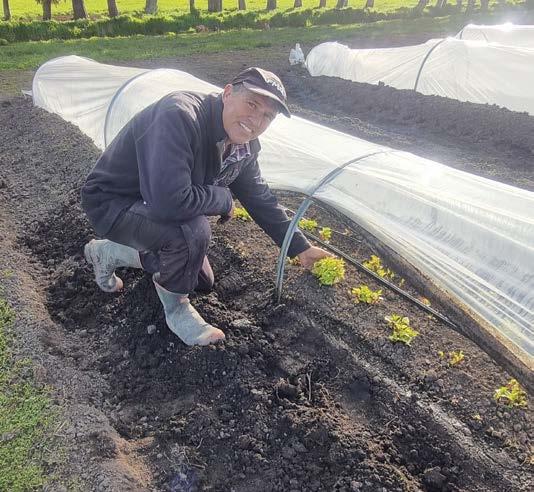
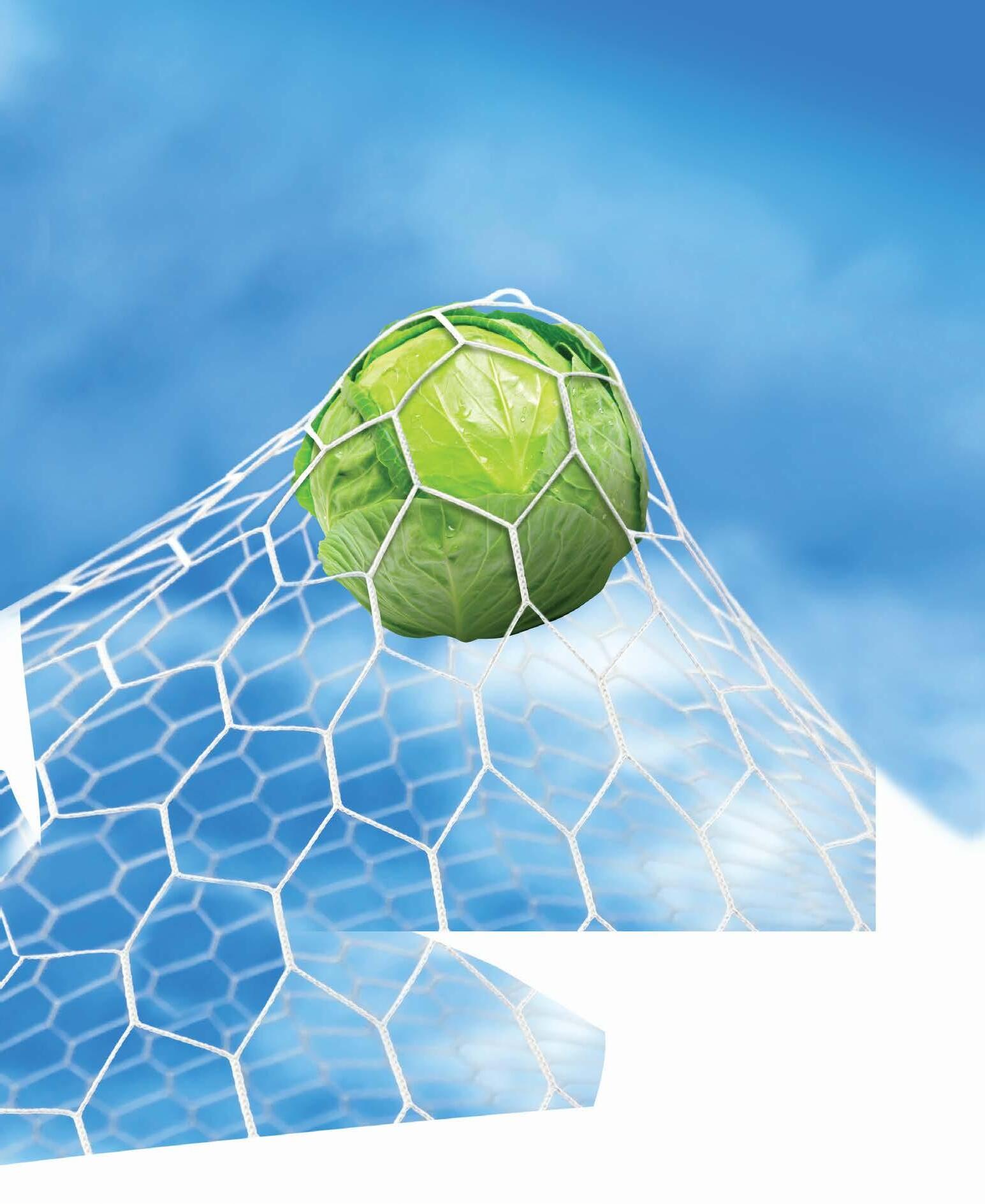
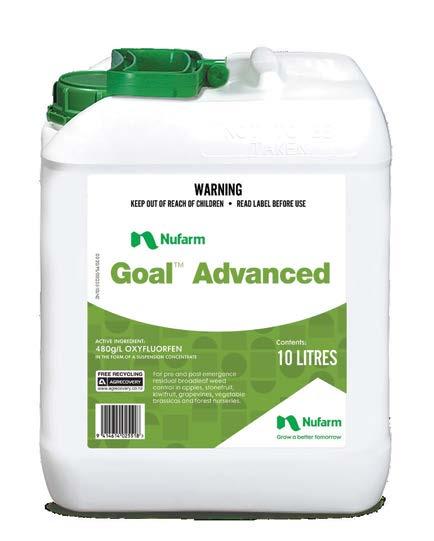
Horticulture New Zealand’s 2022 associate director, Emma Lees, names the biggest benefit she gained from taking on the role as getting a more holistic view of the industry.

“There was so much to the role,” she says. “It was very varied and there was a lot of opportunity to speak to all types of people in the industry and engage with them. I met with growers from all around the country.”
One experience that sticks in her mind is the three days she spent in the South Island meeting with summerfruit growers.
“I knew nothing about cherries, nectarines, apricots etc.,” she says. “The opportunity to see and understand some of the challenges and opportunities in these crops was eye-opening.”
Emma says that also seeing first-hand the HortNZ and industry response to Cyclone Gabrielle was a huge learning.
“Some of the board directors were personally affected by the cyclone. Hearing their stories and being part of the board and HortNZ response, including advocating to the government on the industry’s behalf was a huge personal learning.”
AS Wilcox managing director, Kevin Wilcox, first drew the associate director role to her attention, suggesting it would be good opportunity to continue her personal development.
“It was a good way to give back, fitted with my future career development as well as being a good chance for personal growth,” she says.
“There was a really good induction process and I was made to feel welcome from day one.”
Not only did board members encourage her questioning, they also provided clarification where it was required.
“It’s a really well-structured board working across a complex industry,” she says.
She had been at AS Wilcox for 18 months when the opportunity arose, having spent the previous 15 years in strategic human resources leadership roles in the United Kingdom and New Zealand, focusing on
governance, organisational performance and culture. The organisations she has worked for include Airwork Holdings in New Zealand, Cambridge University’s School of Biological Sciences in the United Kingdom and Syngenta in Europe.
Another highlight of her year in the associate director role was attending and meeting finalists in the Young Grower of the Year competition.
“It was exciting to see really focused young leaders with innovative mindsets,” she says.
An aspect of horticulture she was able to develop a deeper understanding of was the Recognised Seasonal Employer (RSE) scheme.
“I didn’t have an in-depth knowledge about how the political landscape keeps moving in this area.”
Emma realised soon after taking up the role in late February last year she had underestimated the time commitment being an associate director involved.
“It’s not just reading board papers and attending the board meetings” she says.
“There is also engagement with growers, attendance at other events as a board representative and then reviewing learnings personally. However, the associate director role gave me so much. I am very grateful to have been awarded the opportunity.”
Now she’s keen to start looking at what governance opportunities she will next seek out. While she would like that to be in horticulture, she will also look to a role in the charitable sector over the next year.
And because of her HortNZ experience – “I’ll be really confident going into that.”
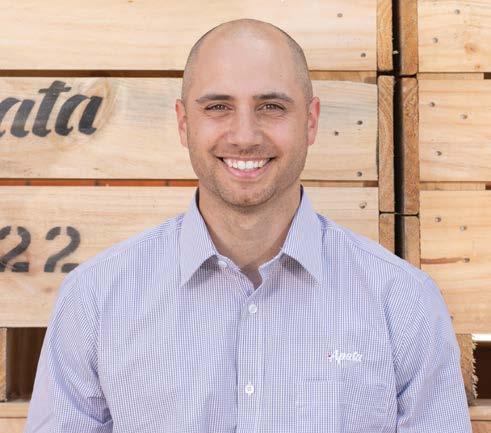
The associate director initiative is a development opportunity for a future leader to join the Horticulture New Zealand Board in a non-voting role and gain experience in governance, leadership and strategy. This year the board has appointed Logan Whenuaroa, avocado manager at Apata Group. His experience includes roles as executive committee member and chair of the New Zealand Avocado Packer Forum; NZ avocado, quality standards and export marketing strategy (EMS) review committees; and advising independent orchards on nutritional inputs, pruning, irrigation and agrichemical use. He has a Bachelor of Agricultural Science from Massey University.

Mycorrcin - activates the soil microbes that enhance root growth & nutrient uptake. Foliacin - activates foliar biology for foliar health and lifts photosynthesis. Digester - activates decomposition microbes to break down old crops & recycle nutrients faster. Biostart N - nitrogen fixing bacteria that provides nitrogen to your plants without excess runoff. Terracin - rebalances soil biology Triplex - controls botrytis.









At
Conference,
Max Lilley took home the Bledisloe Cup, awarded annually in recognition of individuals who have made an outstanding and meritorious contribution to horticulture. He shared some of his career milestones with ELAINE FISHER.
Fifty years ago vegetable grower Max Lilley was among the first New Zealanders to try a strange new green vegetable, and he wasn’t impressed.
“Our friend Murray Stephens invited Margaret and I to dinner. We were invited to try this unusual vegetable no one had ever seen before, which Lincoln University was trialling. There was a great discussion about it. Margaret liked it. I wasn’t keen on it. Little did we know how huge the broccoli market would become,” says Max, who was awarded the horticulture Bledisloe Cup at the Horticulture Conference 2023.
Max went on to be a major grower of broccoli, now among New Zealanders’ favourite vegetables. While the strange vegetable may not have initially appealed to Max, his instinct for other future directions of the industry were never wrong.
Max’s earliest memories of vegetable growing are of hoeing mangel beets for pocket money when he was about eight years old. “It was a terrible job, but if you didn’t hoe mangels you didn’t get pocket money.”
His father Ray and uncle Colin were mixed cropping farmers at Southbridge. “It was just after the War, and no one had much money. I remember Mum and Dad with the
ration book deciding what they could buy with coupons. It was an era of toughness. You had to be careful with money. We never had much, as the whole war effort took the sting out of the country. But that was how it was. You grew up with the times.”
Some would say things got tougher for Max when he left home to become a border at Timaru Boys’ High School. “In the fourth form I was in the open-air dorms of Thomas House. There were no windows. The worst thing was that fourth formers had to clean the dorm and in the autumn the leaves kept blowing in. I never missed the windows at all. The dorm is all covered in now.”

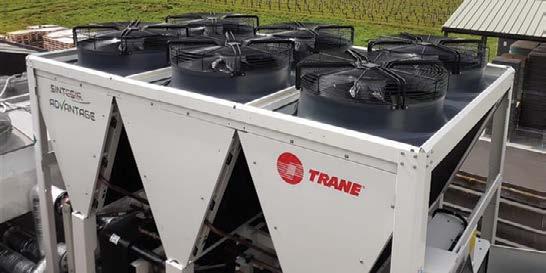

When he left school, Max took a job as a fitter welder, skills which came in handy when he operated his own machinery. Later he worked with his father and brother on the Southbridge farm.

In 1958 the family farm introduced irrigation. “It was a towline on skids with five-inch pipes, big heavy beasts to move around.” In the early 1960s the Lilley family began growing peas, beans, cauliflower and Brussels sprouts for food processor Wattie’s.
“Later we grew mechanical harvest tomatoes for a pickle factory. The definition of a mechanical harvest tomato was one you could drop from a metre, and it maintains its shape and doesn’t break. They were beautiful tomatoes. I don’t think you can get them anymore.
“Harvesting them was backbreaking work. I got my ears pinned back severely by the buyer because I had not sprayed them when I should.
“From then on, my mantra has been “Tight Management”. The tough stuff about vegetable growing is that if you want to do it properly, you have got to do everything at the right time.”
When Wattie’s bypassed a 23-acre crop of cauliflower for processing, the Lilley family got into direct marketing. “They paid us for the crop and said we could sell it if we wanted. We carted cauli all over Canterbury direct selling to supermarkets and were rather pleased with the results. We also grew broccoli for ourselves alongside Wattie’s crop.
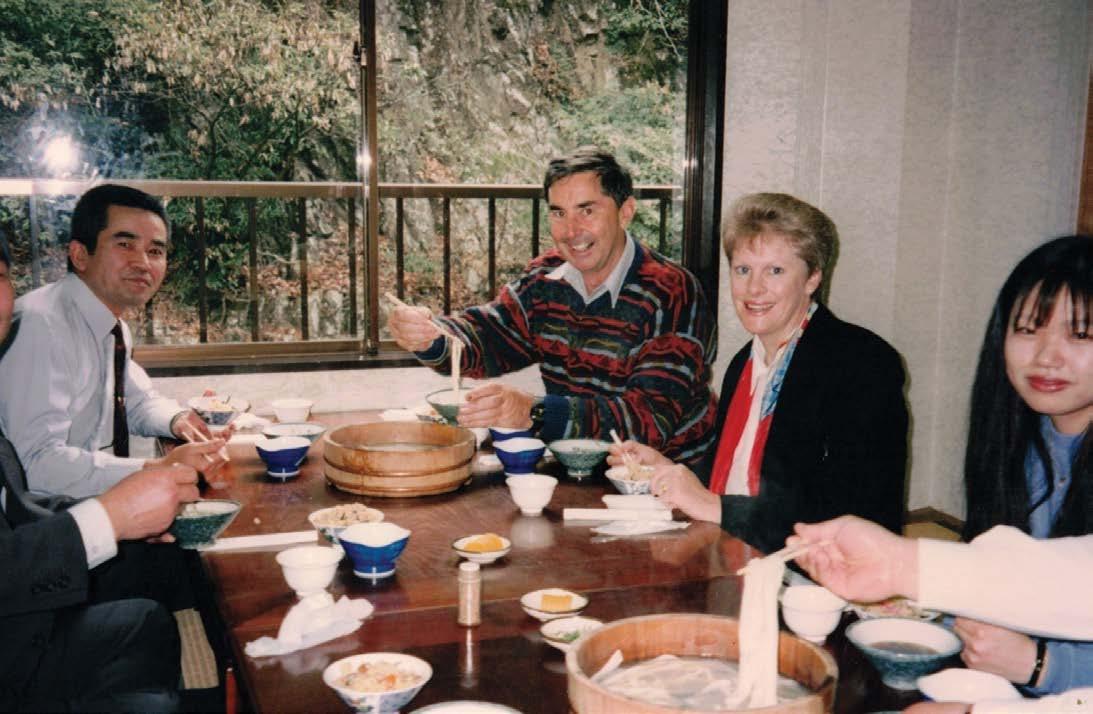
“As well as broccoli we were growing Brussels sprouts, for which we imported a harvester, and when Wattie’s decided to withdraw from that crop, we continued growing broccoli, developing and selling that crop for the fresh market.”
The family was approached by a Progressive representative to grow broccoli directly for the supermarket. “We knew the rest of the growers would not take too well to that idea, but Progressive guaranteed to support us, and after a couple of years the market got used to the idea.”
In 1990 when his father Ray passed away, the family farm was sold, and Max and Margaret decided to go out on their own. “We wanted somewhere closer to the markets and with the right soils. We chucked a spade in the boot and drove north, looking at every lifestyle block for sale.”
WHEN HE WAS ABOUT EIGHT YEARS OLD
MAX’S EARLIEST MEMORIES OF VEGETABLE GROWING ARE OF HOEING MANGEL BEETS FOR POCKET MONEY
The soil Margaret and Max wanted was Templeton Silt Loam and they found it on a former apple orchard near Rolleston. “We put the spade down and found beautiful soil, wow 2.3 meters down to the first stone.ˮ
Leasing additional land, the couple returned to growing broccoli and later downsized to grow pak choy and Shanghai pak choy on their 3.8-hectare block. “It was quite comfortable financially, but by 2014 I was getting sick of crawling round the paddock picking greens. I told my neighbour Allen Lim I was going to tell the supermarket I’d had enough.
“Over a cup of coffee, we decided to bring our two businesses together. I said you are the boss and I’m unreliable. Today it’s Jade Garden Produce, with a wonderful staff who play an active part in it. I don’t play much of a role, though my business card says I’m a technical advisor – I’m more of a mentor I think.”
In 2019, Margaret Lilley died in a mountain biking accident. “Life around here is pretty quiet now,” says Max who, as well as maintaining the home garden, still pursues the sports of skiing and mountain biking he and Margaret loved to share.
“She was a remarkable woman, and I could not have done all I have without her help and support,” says Max.
Alongside his career as a vegetable grower, Max was chairman of the Canterbury Growers Society Process section, playing a key role in successful price negotiations with processors, which brought growers a 15 percent increase in returns for some crops.
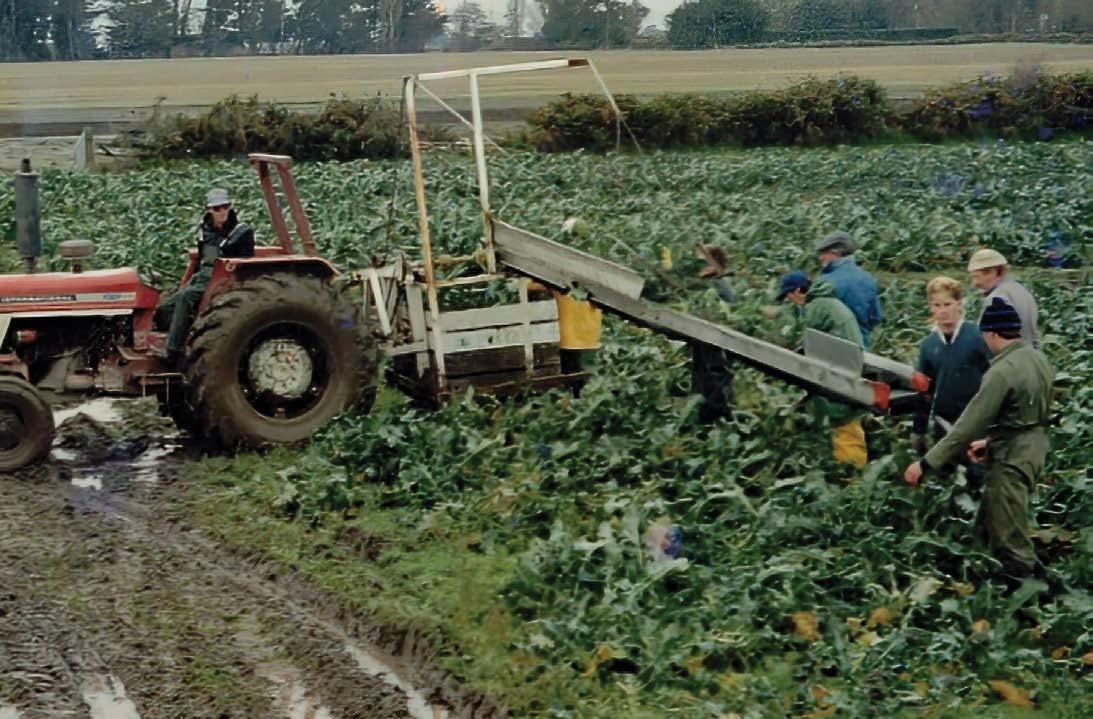
For 17 years Max served on the processor sector of the Vegfed (NZ Vegetable and Potato Growers Federation) council, becoming Vegfed president in 1990. During his time on the council Max served on the rural safety, the cultivars advisory and the quarantine committees. He was a director of Vegetable Producers Publishing Company and Vegfed’s environmental spokesperson during the development of the Resource Management Act.
When Max was Vegfed president, the Commodity Levies Act was introduced, and he led the organisation through a successful process and outcome. Max also worked on closer relationships with Federated Farmers.
Today, Max chairs the Growers’ Trading Company Trust, created when the company was sold to Farmlands. The proceeds of the sale were used to set up a trust for the advancement of horticulture in Canterbury. He also continues to be an active member of the Canterbury Growers’ Association.
In awarding Max Lilley the Bledisloe Cup, HortNZ board chair Barry O’Neil described him as “one of the visionaries behind the formation of Horticulture New Zealand”.

It was while chairing a Trans-Tasman Horticultural Conference in Sydney that Max saw first-hand the strength of the New Zealand Fruitgrowers’ Federation’s relationship with government.
“Back then Australia would not allow the import of New Zealand apples. Among the reasons was the claim the disease fire blight was not present in Australia. During the conference a couple of guys, who shall remain nameless, took a trip around Sydney and found fire blight.
“They came back to tell me, saying they were going to ring the Agriculture Minister and tell him ‘and there will be hell to pay’. What impressed me was as soon as one of New Zealand’s largest product groups got involved with government, they listened and the pressure of Fruitfed (New Zealand Fruitgrowers’ Federation) and the apple industry together loosened up the ability to export apples.
“That sort of stuff made me realise we needed to amalgamate, because fruit growers had more power than vegetable growers and got ministers to listen to them.”
At the time Max was president of Vegfed (NZ Vegetable and Potato Growers Federation). “Vegfed was so small that we never got much recognition at a political level. We had to plead with government to take note of us when drafting legislation.”
Vegfed did have a close working relationship with the NZ Fruitgrowers’ Federation, including sharing chief executive Peter Silcock. “I discussed my idea for amalgamation with Peter then went to the Marlborough Sounds, meeting Fruitgrowers’ Federation president Martin Clements. Sitting on the beach enjoying a couple of beers we worked out a plan.
“He went back to his board, and I went to mine to put the proposal, which was accepted. Then I buggered off (from the president’s role) and left them to it.”
Max is proud of Horticulture New Zealand, which was formed in a merger of the New Zealand Fruitgrowers’ Federation, the New Zealand Vegetable and Potato Growers Federation, and New Zealand Berryfruit Growersʼ Federation in December 2005.
“HortNZ does a hell of a good job for our industry. I was impressed to see members of parliament, ministers and the diplomatic core at the Horticulture Conference in August.”
Individual grower sector groups did not lose their autonomy in the merger. “All the sectors can do their own thing, but come together through HortNZ for the good of the whole industry.”
Congratulations to all six finalists who took part in the 2023 Young Grower of the Year national final in Pukekohe this October.
Please contact Kerrin.Burns@hortnz.co.nz for 2024 sponsorship opportunities. Dates for the 2024 competition will be released in the coming months. Visit www.younggrower.co.nz for more detail.




A SPECIAL THANKS TO ALL OF OUR 2023 SPONSORS:


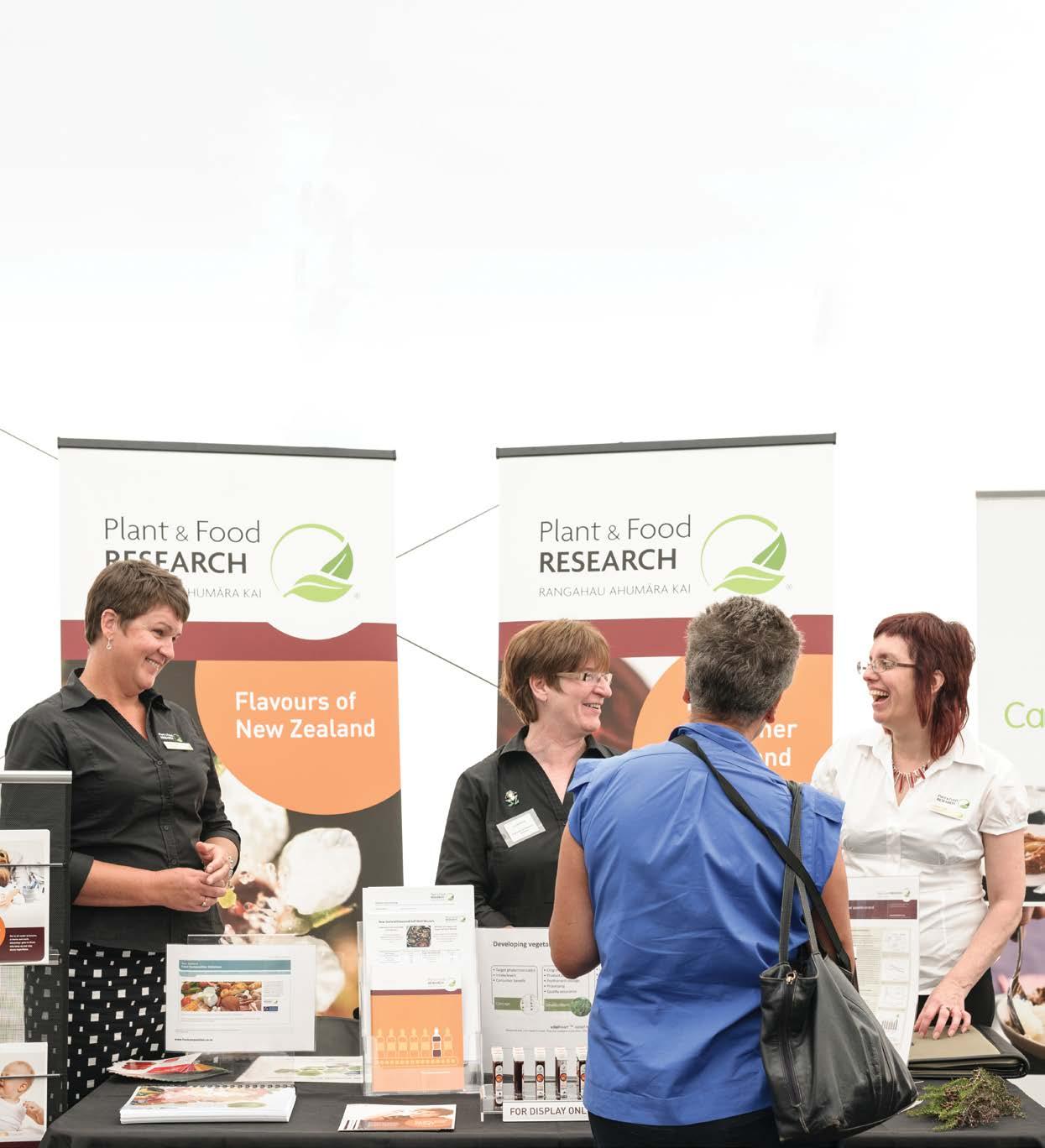

Pukekohe vegetable growers, Jivan Produce, don’t want others to go through what they recently have. So their aim is to make the entire sector more aware of workplace safety obligations, especially when it comes to checking for the correct guards fitted on to all machinery to avoid accidents.
Back in May last year while a supervisor had stepped away to a different part of their packing shed, an onion scroll topper, used to take the tops off pickling onions, became blocked. An experienced worker in the packing shed in his second season, but unfamiliar with that particular machine (and unaware of the danger he was putting himself in), went over trying to help. He opened an access door and tried to remove the blockage with his hands but without turning the machine off, ultimately resulting in him losing several fingers of his left hand.
In July, the company pleaded guilty in the Pukekohe District Court to a charge under section 36 of the Health and Safety at Work Act 2015 for failing to ensure the safety of workers. The sentencing will take place in the same court in late November. The fines under the 2015 Act are significant as on top of reparation compensation to the worker the company faces a maximum fine of $1.5 million. The worker has recovered well and returned to work, which is good, but the consequences for all are significant.
The machine, in use since the 1970s, was designed by a local engineering company and most likely there are a number of similar machines still in use around the region. While growers might have good general knowledge about guards for machines, they might not be aware of the important expectations of AS/NZS 4024 which is a complex series of standards addressing all aspects of safe machine guarding. WorkSafe NZ also has a Best Practice Guidelines reference document (2014) available online which sets out similar expectations, and some help, for the safe use of machinery. Growers should look into these standards and guidelines if they have not already, says Jivan Produce’s lawyer, barrister Brett Harris.

The topper, which isn’t used all the time, would occasionally slow down with onion tops, so clearing it was not a regular task. But it still needed to happen, and although the machine has a physical guard around most parts, the inspection hatch was not locked or interlocked, meaning workers could potentially access behind it without it being stopped. WorkSafe inspectors had previously viewed the packing shed but they had not commented specifically on this issue.


After the accident, Jivan Produce took the whole machine out of its packing shed and off to a local engineering firm to be modified to bring it fully up to AS/NZS4024. That took a considerable amount of time and it cost $25,000, which the company believes is money well spent after the consequences for the worker and the immense stress of the accident with the likely fines to follow. The access door was replaced with a fixed grille. All guarding and panels are now secured using security screws which are unable to be removed by a normal spanner or wrench. A hexagonal bolt is not acceptable under the regulations. The security screws require a special tool to be used, which is not kept close at hand, to make it even more difficult for workers to try to get access.
A panel at the side of the machine has also been lengthened so it is impossible for someone to reach up to try to unblock the machine. There are various specified ergonomic safety distances such as 850 millimetres, so an extended arm cannot reach into a danger zone. Guards were also placed around bin tippers, with more signage warning of the dangers of the machinery.

Jivan Produce found out in April it would be prosecuted, and they want growers to do all they can possibly do to avoid this situation for everyone. The investigation and court process is not a pleasant experience. They recommend getting prompt legal
advice and checking with insurers to see if there is any cover that may assist with such events, like statutory liability cover. They were unaware of some of the resources available from WorkSafe NZ, including free WorkSafe onsite presentations on the dangers of working around machinery, and brochures on the health and safety rights and responsibilities of employers and employees, in a range of different languages.
Brett Harris stressed it is also possible to apply for an enforceable undertaking, an out of court process designed to allow the regulator to approve safety improvements delivering better outcomes for an industry and the country. All these things require care and advice, and for those other growers facing concerns about guarding or other health and safety issues, he hopes there is awareness of what he says is the great work being done by Grow Home Safe.
www.growhomesafe.co.nz

Delivering a complete suite of crop protection solutions for today’s horticulturists.
Our portfolio of powerful, proven products has helped growers from one end of New Zealand to the other create and maintain thriving businesses, and has earned us an excellent reputation in horticultural crop protection.
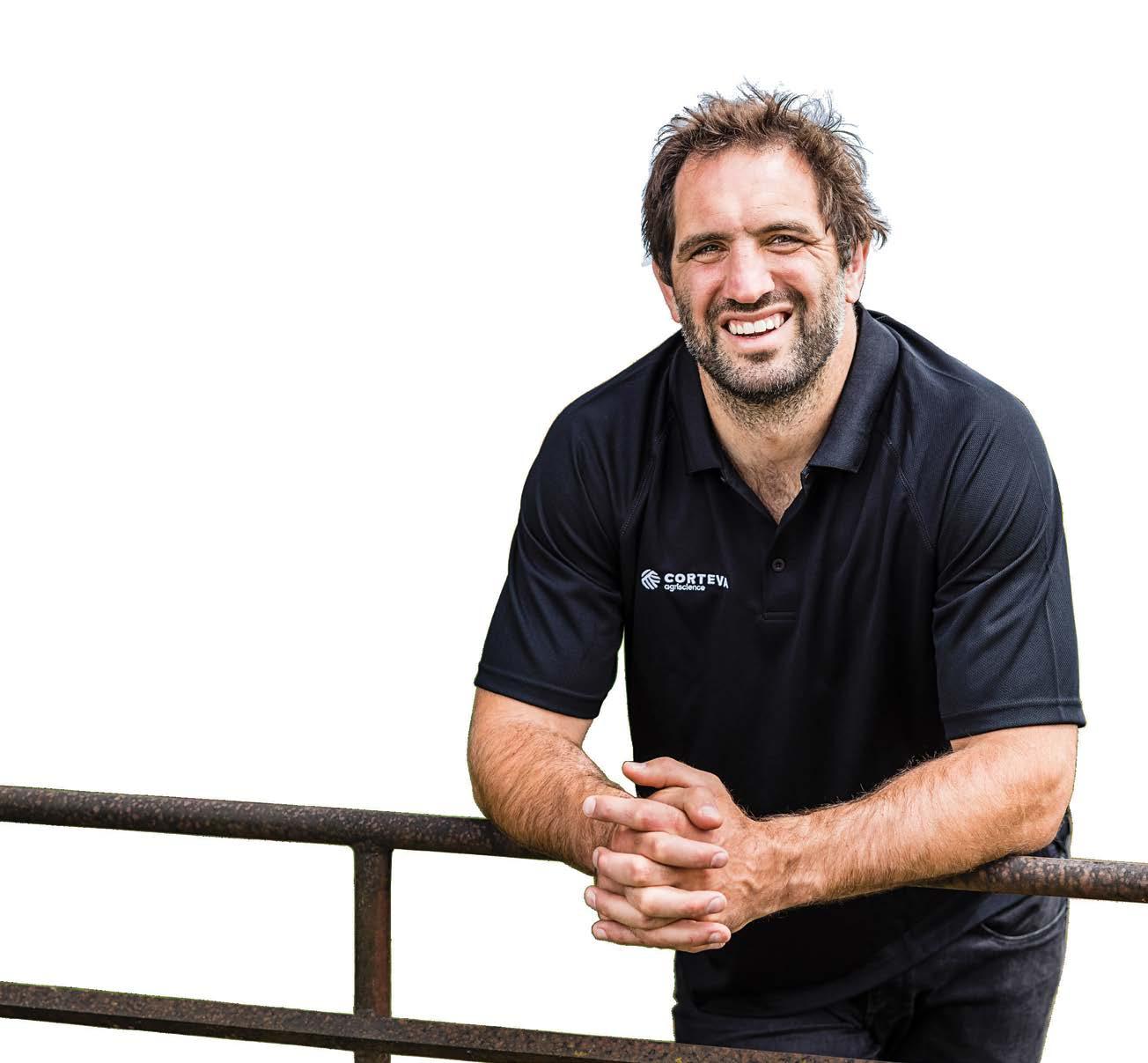
Our suite of insecticides and fungicides provide growers with everything they need in the war against pests and diseases. Visit corteva.co.nz to view our range of products and online horticultural resources.

A determination to honour the country’s rich horticultural past while dealing with the challenges of the day and preparing for the future is a key part of Bobby Lowe’s vision for the industry. HELENA O’NEILL talks to Vegetables New Zealand’s newest associate director about his background, the family business, and his hopes for horticulture.
The associate director initiative is an opportunity to build on his management and leadership background, while also giving back to the horticulture industry, Bobby says.
“I felt that I could give more back to the industry at some point so when the internship came up, I was quite curious about it. I knew there was a Horticulture New Zealand
internship as well but the Vegetables New Zealand one was a bit more appealing as we operate in that field. I wanted to see if my experiences and the things I learned overseas were relevant or applicable to Vegetables New Zealand.”
The associate director (formerly future director) initiative is a development opportunity for a future leader to join the Vegetables New Zealand (VNZI) board and gain experience in governance, leadership, and strategy.
The opportunity builds on the future leader’s current horticulture experience and prepares them for governance roles in the horticulture sector. The associate director is mentored by an industry leader and undertakes governance training. While this is a non-voting role, the board seeks full participation in meetings and constructive contributions from the associate director in the workings of the board.
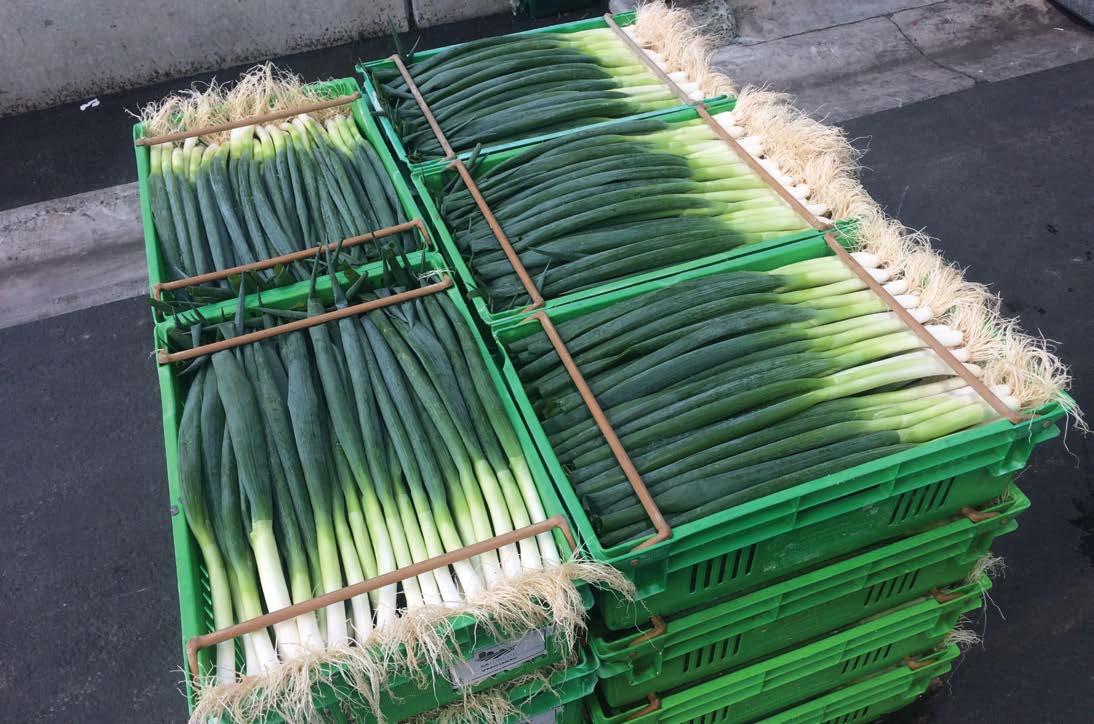
Bobby hasn’t worked at a board level before, so the programme offers more insight into how these organisations are run, how decisions are made, and how policies are set, he says.
Bobby works two jobs: one as a design manager overseeing a team of nine based in Australia while working remotely from his home in New Zealand, and the other as commercial manager for SKL Produce, the family market garden.
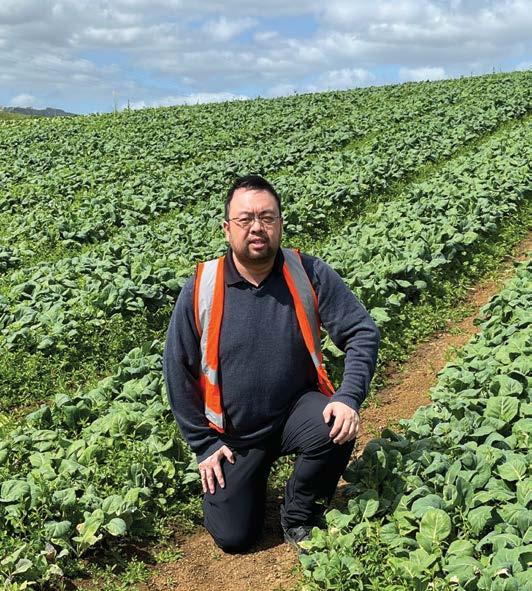
The SKL Produce business logo was designed by Bobby more than ten years ago and features an eye-catching image of a tractor and farm buildings imposed into a chopping board. Bobby says that there are some limitations with the design but overall it suits the family business.
Maximise coverage, efficiencies and savings


Du-Wett® delivers superior spreading using less water. That saves time, labour, and fuel. And because Du-Wett optimises efficacy, you get the most out of every cent you spend on your spray programme.

I want all New Zealanders to know about the past and the shoulders that we stand on todayVegetables New Zealand’s new associate director Bobby Lowe at the family market garden at Runciman, south of Auckland
“We don’t market to retailers directly, we don’t brand our product, we just sell wholesale to Jeffery and Peter Turner at Fresh Direct. My parents feel that loyalty to them because they have looked after them for decades.”

SKL Produce grew from a small 1.6-hectare block in Glenbrook, southwest of Auckland and is now located in Runciman across 28 hectares. The business has three core lines: spring onions, Shanghai bok choy, and kailaan (gai lan). They also grow a small number of other vegetables including carrots and snow peas.
The first part of Bobby’s professional life was not spent in horticulture. After high school, he went to Sydney to study industrial design and engineering, working in Australia for three years before returning home. He worked in industrial design in Auckland before joining the family business in 2012 in a range of roles. For four years he worked on the farm, but the business struggled to secure enough labour.
“We weren’t profitable at that time … I wasn’t drawing a salary at all. It was a bit dire, so I decided to step away, gaining employment outside of the business as a design manager. We scaled back to two or three employees; we managed a consistent level of supply where we could maintain a profit. We maintain an okay lifestyle and an okay margin and that’s enough for my parents.”
Bobby also serves as co-treasurer and secretary for the Dominion Federation of NZ Chinese Commercial Growers which held its 81st conference dinner in Auckland last month.
“My vision for the sector is very broad. There is a strategy that I’m aiming to implement with the Chinese growers’ association and it’s what I call PPF: past, present, future. I want all New Zealanders to know about the past and the shoulders that we stand on today.
A lot of history and institutional knowledge is passing away. I think people take the past for granted. I understand that there are trophies in recognition of contributions made to the industry, but I don’t think the stories are told enough about these people. I love the Sons of the Soil book, but I don’t know that there is a book for other growers and their communities. I would love to read a book like that.”
Sons of the Soil: Chinese Market Gardeners in New Zealand was written by Lily Lee and Ruth Lam and published in 2012. It incorporates more than
100 interviews with Chinese fruit and vegetable growers from across the country and features both historic and contemporary photos.
“For the present, dealing with the challenges of the day like weather events, or global pressures, economic issues and so on. The future is all about policy setting and technology – I’m a big proponent of bringing in technology … applicable technology to the grower that is economically viable.”
As for new strategies or fresh ideas to bring to Vegetables NZ, Bobby says collaboration with other industries and government departments is key to future-proofing horticulture.
“One of my goals is to increase our collaboration between VNZI, the Ministry of Health (MoH) and the fastfood industry. The New Zealand fast-food and takeaway market is approximately $3.4 billion annually. Many studies show how people make daily food choices based on price, convenience, taste, income and health. Collaboration between the MoH, the fast-food Industry and VNZI is vital to improving the overall health outcomes of New Zealand.”
Bobby aims to double the vegetables inside a Big Mac and reduce the starch and calorie level in chips.
“Is a healthy pie possible? I do not preach a specific diet as, due to lifestyle circumstances, it would be hypocritical. I have conditioned my child that a Happy Meal is a reward. I want to educate people on how to dress up a KFC bucket to be a healthier option.”
He says such a collaboration aims to create a profit for farmers and the fast-food industry. It is only sustainable when both sides can profit.
“The aim is to reduce the long-term health costs in New Zealand, in small steps.”
Furatto is a flatter drumhead cabbage for the warmer months, December to May dependent on location. Flat in shape with well filled dense heads weighing 3kg. Good ground clearance and easy harvest. Good field tolerance to disease.
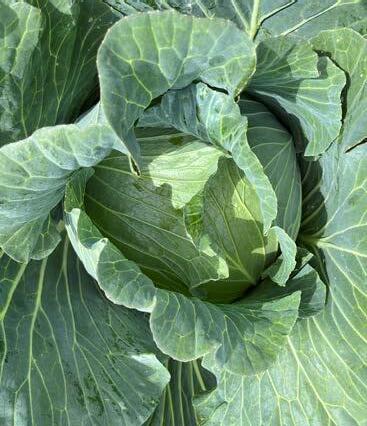
New this year, Inca is a sutured rock melon with extended shelf life. Strong vine, good canopy cover, yielding great fruit numbers, and excellent shipping and storage ability. Sweet flavour with 12-14°Bx. Weight 1.6-1.8kg. HR: Fom:0-2, Px:1,2, Gc:1,2
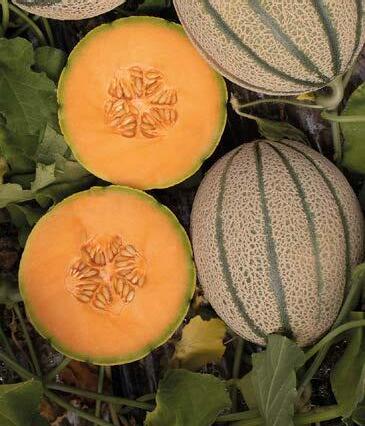
New this year, Devotion is a versatile Nantes carrot 16-18cm long with a nice blunt end, good tops and smooth root. Bright colour, minimal cracking, excellent uniformity and storage ability. Sow October to January dependent on location.

Scientific research is continually identifying the health benefits of individual fruits and vegetables but there is no one ‘super food’, says Dr Carolyn Lister of Plant & Food Research Limited.
“Certain foods are good for certain things such as blackcurrants which can help in sports recovery, blueberries for brain health and broccoli which may help reduce the risk of certain cancers, but the most important thing is to eat a balanced diet,” says Carolyn who is a principal scientist and leads the food and health information team at Plant & Food Research and is a member of Women in Horticulture.
Carolyn, based in Lincoln, just out of Christchurch, has spent close to three decades researching plants and their beneficial properties for human health. Today she leads a team which manages the New Zealand Food Composition Database (foodcompostion.co.nz) and conducts research to understand the factors impacting the nutritional and phytochemical composition of a range of foods and some animal feeds.


“We also work with companies to develop nutrition and health claims for foods and to promote greater consumption of plant-based foods. A key developing area of research is centred on nutritional sustainability,

nutrition sensitive agriculture and regenerative agriculture impacts on food quality.”
In the 1990s, when Carolyn began her PhD studies, research into plant pigments and human health was relatively new and exciting. “Thirty years ago, much of the work in that area was to find a ‘magic bullet’; the plant pigment which would deliver the greatest health benefit. But the realisation now is that different plants deliver different benefits through their unique composition of compounds, delivering wellness and health in the broadest sense, rather than to prevent or cure one particular disease.”
Carolyn, who grew up in Ashburton and then Blenheim began working with plants almost as soon as she could walk. “My parents were both English teachers and we were a ‘townie’ family but always had big vegetable gardens. I still have a scar from when I was about two and tripped and broke a jug I was using to water plants, cutting my hand.”
That experience didn’t deter Carolyn and as she went through primary school, she entered gardening competitions. It was winning a Third Form (Year 9) college science fair award from the then Department of Scientific and Industrial Research (DSIR) that inspired Carolyn to commit to a career in science.
“When I won the award, I decided I would one day work for the DSIR.” Soon after leaving the University of
Canterbury with a BSc (Hons) in plant biochemistry, Carolyn was employed by the DSIR where she completed her PhD studies investigating the skin colour of apples and how it could be manipulated to appeal to the Japanese market.
In 1997 Carolyn gained a fellowship at the University of Glasgow. “That fuelled my interest in the role of plant pigments in human health. The international experience, working so closely and connecting with other researchers, was invaluable and I am still in touch with many of the people I met then.”
However, New Zealand was home so Carolyn returned to continue her research into plant biochemistry. That research has covered a wide variety of crops including tomatoes, potatoes, lettuce, blackcurrants, green tea, broccoli sprouts and Californian poppy.
The diversity of work includes commissions from companies seeking to establish the nutritional benefits of their products, and some prompted by her personal interest.
“The initial work I did on blackcurrants and their health benefits came from a conversation with a colleague at the pub one evening.”
While Carolyn doesn’t spend as much time in the lab as she did earlier in her career, there’s always something new to discover about the benefits of plants which keeps her motivated and enjoying her work. “I also love interacting with academics and the general public, and I’m passionate about communicating science to the community.
“I think communication has become even more important in recent years to combat some of the misinformation and disinformation that’s around and to demystify science so that people can better understand and are able to use scientific information.
“I enjoy working with school students and the 5+ A Day education programme to promote an interest in science and nutrition,” says Carolyn who is a member of the board of trustees for 5+ A Day.

Science wasn’t high on the list of careers for young women when Carolyn was at college, but she is pleased that more women are now entering the field. “We need diversity within the science community, and I think women bring a slightly different perspective to the field.”
To keep up-to-date with Women in Horticulture, its news and activities, and join the membership database, email info@women-in-hort.nz
Everyone is welcome.
Kni ed polyethylene frostcloth or crop cover. 2m -16m widths. Promotes growth & yield!

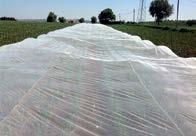

Super ne, lightweight insect ne ing. Excludes - Psyllids, Carrot Flies & rips.
Heavyweight, nely woven HDPE, providing insect, pest and weather protection for larger semipermanent structures. Biorete promotes air movement for low humidity and an improved microclimate.
POLYNET PRODUCTS LTD

PO Box 38092 Parklands Christchurch
Phone: 03 382 9230 email:polynet@xtra.co.nz

For - fencing, reinforcing, bird / pest exclusion, drying, safety and more...
8

Could pineapples be a new crop to help growers diversify, particularly kumara growers with existing machinery for planting in mounds? Since Covid-19, there has been an increasing interest in sourcing locally grown food with a known story, and this includes tropical fruit as growers explore what else might thrive in our subtropical regions in a potentially warming climate.
New Zealand’s only commercial pineapple growers, Owen and Linda Schafli, have grown and harvested thousands of pineapples near Whangarei in recent years as their project comes to fruition. “We harvested our first sizeable crop in 2021 after seven years of building up our plant numbers,” Owen says, “and the fruit is much loved by our customers. We’ve run out of land here with 1.3 hectares in pineapples,
so now that we’ve proved they can be a viable crop in warm areas in New Zealand, we’re ready to share our knowledge and plants with other potential growers.”
“We would like to encourage commercial growers to diversify into pineapples on their existing kiwifruit, kumara or dairy farm properties, especially if they have suitable machinery for planting in mounds. While we know pineapples can grow here in warm Northland sites, other coastal regions like Gisborne and Bay of Plenty are also potential locations.”
Owen Schafli grew tropical fruit in South Africa before the family moved to New Zealand in 2008 and later bought property near Whangarei to grow mainly bananas and pineapples.
“We initially planted several banana varieties for a cash crop while we experimented with growing pineapples,” Owen says. “We bought the first plants from a friend, trialled them in mounds on our higher ground, and
when we knew they would grow and fruit well we started taking suckers to build up plant numbers, and preparing the land for planting to make the best economic use of our sloping property.”

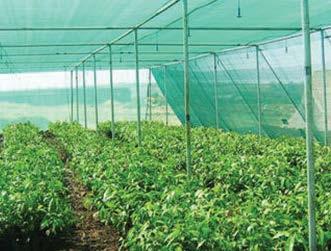

When the Schaflis were propagating from every small sucker, the plants took two to four years to flower, but their mature plants now provide a good supply of larger suckers that will flower in one to two years, with a further few months until pineapple harvest. By the end of 2021 they had 40,000 pineapple plants in the ground and have since increased their numbers to nearly 50,000.
Part of Schalfis’ pineapple growing success is their choice of the Queen variety. It’s a small gourmet pineapple that is super-sweet, golden yellow, has an edible core, a good shelf life and multiplies faster than some varieties. It’s an old cultivar still grown in Australia, India and South Africa for fresh fruit rather than canning. It also has a better tolerance of cold, disease and stress than Cayenne, the main commercial pineapple variety grown worldwide and imported here.
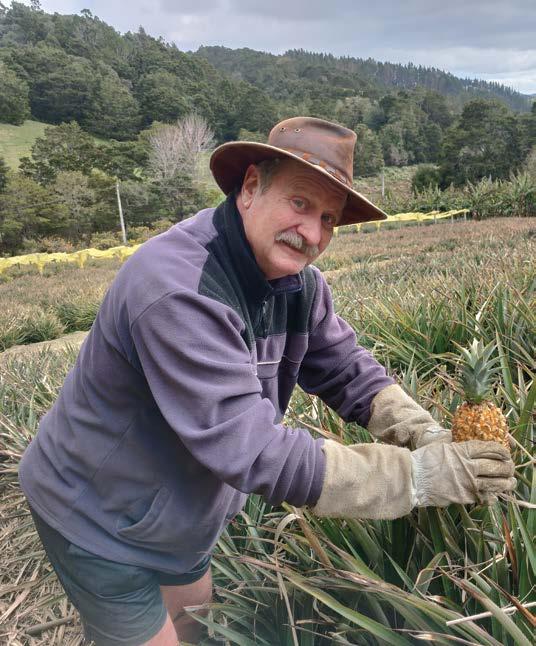
“Cayenne is well suited for large scale harvesting and processing because the big fruit fit the cans with little waste,” Linda explains. “The plants are usually sprayed to induce uniform flowering and harvest times, and are picked unripe then gas ripened for fresh fruit export. We chose Queen to give New Zealanders the option of a super-sweet locally grown pineapple that is spray free and available nearly year-round.”
Pineapples like warmth, protection from frost, rich slightly acid soil, and free-draining ground, and they’re slightly more cold-hardy than bananas. “They’re in the bromeliad family so they like humidity but they hate wet cold ground,” Owen explains, “so we plant the suckers straight into mounds in October when the ground has warmed up. We can plant four rows in one mound for optimal land use without crowding the plants, and we protect some of the lower blocks with frost-cover during the cooler months.”
Pineapples are seldom irrigated where they are grown commercially in the tropics, but they do need enough moisture for the developing fruit to fill out and mature. “Ideally pineapples love a hot wet summer,” Owen adds, “but so far we’ve managed to get away without irrigation. Northland is usually humid, and because our crop is yearround we’re not dependent on one season’s weather. We initially had some root rot problems which we’ve now solved with good hygiene, and we’ve managed to stay spray free.”
There are very few pests and diseases affecting pineapples in New Zealand, partly because our cooler climate doesn’t sustain those that are common in the tropics, and partly because there are fewer host plants for them to thrive on.
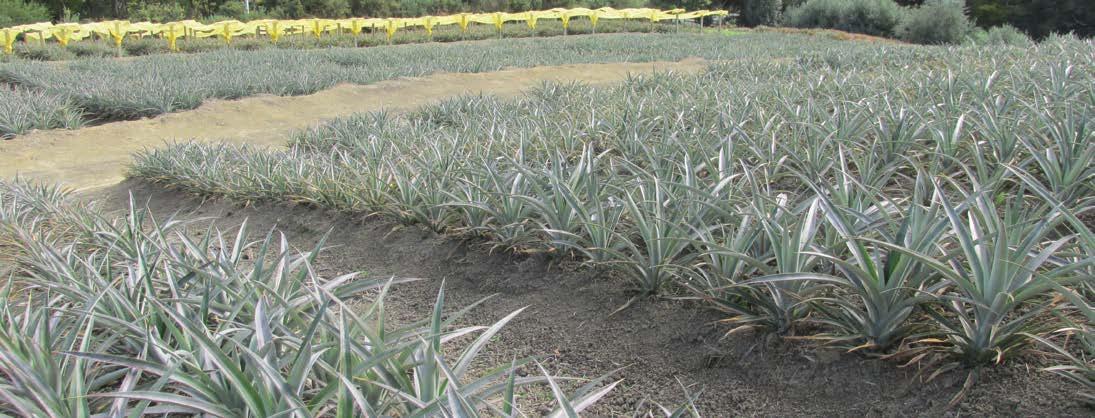
Imported pineapples also now have their leafy tops removed to reduce the biosecurity risk from supermarket fruit being used by insect pests as a source of plant material.
The Schalfis’ whole operation, including picking, is done by hand because of their sloping land and lack of space. “Pineapples are reasonably easy to harvest despite their prickly leaves,” Owen explains, “and we’re able to sell them here with the tops still on. For early harvest in March or April we wait until the fruit is fully orange before picking it, but in August and September we pick as soon as there is a bit of orange to prevent the core going brown, then it colours up in about a week.”
Interest in New Zealand grown pineapples increased dramatically after the Schaflis’ enterprise was featured on Country Calendar, and the exposure helped people realise pineapples could grow outside here. “We regularly sell at the Whangarei Growers’ Market where we were originally known for our bananas,” Owen adds, “and there’s now a huge interest from our customers in the Queen pineapples. We usually sell out, and at our production peak of 700 pineapples at one market last May we sold out by 9.15am, and that was with a limit of six fruit per customer, so we know the market is expanding.”
Owen explains that pineapples will provide a return in one to two years, with the first fruit being the biggest. “After six years mature plants are usually dug out, but they will provide enough suckers for five times the original area, so from one hectare you will have replacement stock for five hectares.”
Linda and Owen have recently been joined by their son Colin, and their focus is now on gearing up to take orders later this year for growers interested in mature Queen pineapple plant suckers for planting in October 2024. “We anticipate selling a minimum of 40,000 plants per grower, ideally to plant at 40,000 plants a hectare, plus we’ll provide knowledge about growing them. We’re keen to support what could become a new small industry.”
IF IT’S FRESH PRODUCE IN NEW ZEALAND, WE HAVE IT COVERED.
Reaching all levy-paying growers of vegetables in New Zealand.




PRINT New Zealand resident NZ$165 (GST inclusive) Australia & the Pacific NZ$280 (airmail delivery) Rest of the World NZ$305 or US equivalent (airmail)
For information about how to subscribe please visit hortnz.co.nz/news-events-and-media/magazines

Shelly O’Shaughnessy is proud when she sees fruit and vegetables attractively displayed in supermarkets and fruit and vegetable stores –not because she’s a grower, but because the company she works for most likely supplied the containers, bins and crates the produce is in.
Shelly is director of sales and support services for CHEP New Zealand, part of a global company which is among the pioneers of the circular business model.
“My kids get tired of me pointing out our products in store, but I’m proud of the services CHEP offers and that what we are doing is important for the future of our children’s children, the community and the environment,” says Shelly who is a member of Women in Horticulture.

The business model for CHEP New Zealand, which celebrates its 50th anniversary next year, is based on the concept of share and reuse, also known as pooling. Customers access the products (pallets, crates, bins, containers and more) from CHEP on a rental basis, reducing upfront capital costs.
Globally CHEP manages, maintains, transports and supplies more than 350 million platforms that are shared and reused by growers, manufacturers, distributors and retailers.
In New Zealand, collectively the supermarket chains and CHEP have achieved major reductions in supply chain environmental impacts. More than 11 million reusable
CHEP crates are in circulation, transporting fresh produce from farms to retail stores across Aotearoa, and replacing the equivalent in single-use cardboard boxes.

“Almost any foods you see in New Zealand supermarkets have arrived on one of our products. In the pallet world we have about 90 percent of the market in New Zealand. Once pallets have reached the end of their lives, they are recycled into chips for children’s playgrounds.”
In her role with CHEP, Shelly works with some of New Zealand’s biggest companies, including the large FMCG (fast moving consumer goods) businesses, markets and retailers, but also with individual growers including small family businesses.
“I know how important it is for growers to have the right products they need at the right time, to harvest and transport their produce, so we are continually innovating to reduce waste and keep costs down.
“The biggest thing in a business which is nearly 50 years old is to keep disrupting our own model with innovation, before others do. We are currently working with growers and retailers on an end-to-end fresh programme including temperature control and track and tracing to improve product quality, which affects growers’ bottom line.”
Another aspect of working for CHEP which appeals to Shelly is that it partners with sustainable foresters. “We have a policy of ethical sourcing for all our products. Share and reuse is in our DNA.”
Shelly’s role is an example of the diverse career opportunities the horticultural industry offers, and it’s one she did not envisage for herself as a teenager.


“I grew up all over the place, but mainly in Auckland and Australia. My high school education was in Christchurch,
and I endured a Bachelor of Education at Canterbury University. Upon graduating, I realised teaching was not what I wanted to do.”
But says Shelly, that degree has not been wasted. “Studying taught me persistence and routine, and about how people learn and develop, which has helped me in my role of coaching and helping develop people in my team.”
Shelly’s CHEP team is diverse and that’s the way she likes it. “We have graduates and high school ‘early leavers’, people of different race, colour, religion and sexuality and I wouldn’t want it any other way. Each brings different strengths to our team. Diversity of thought is vital to our organisation.”
Shelly has been with CHEP for just over six years, and in her current role for 12 months. Previously she has worked in a number of other industries, mostly in customer relations. Shelly has five children, four boys and a girl, aged between nine and 23 years. “With three children still at home, an unpaid Uber driver is my second job, along with being involved in their school activities, but I love it. Family and health must always come first.
“My dad, Alan, taught me not to sweat the small things and not to go to sleep with a bitter taste in your mouth about work or relationships. I tell my team at work that if you get those things right, work and life will flow so much better.”
To join Women in Horticulture, visit: www.unitedfresh.co.nz

Follow us on LinkedIn: women-in-horticulture

THE LATEST INNOVATIONS AND IMPROVEMENTS
35 LOOMING DROUGHT?
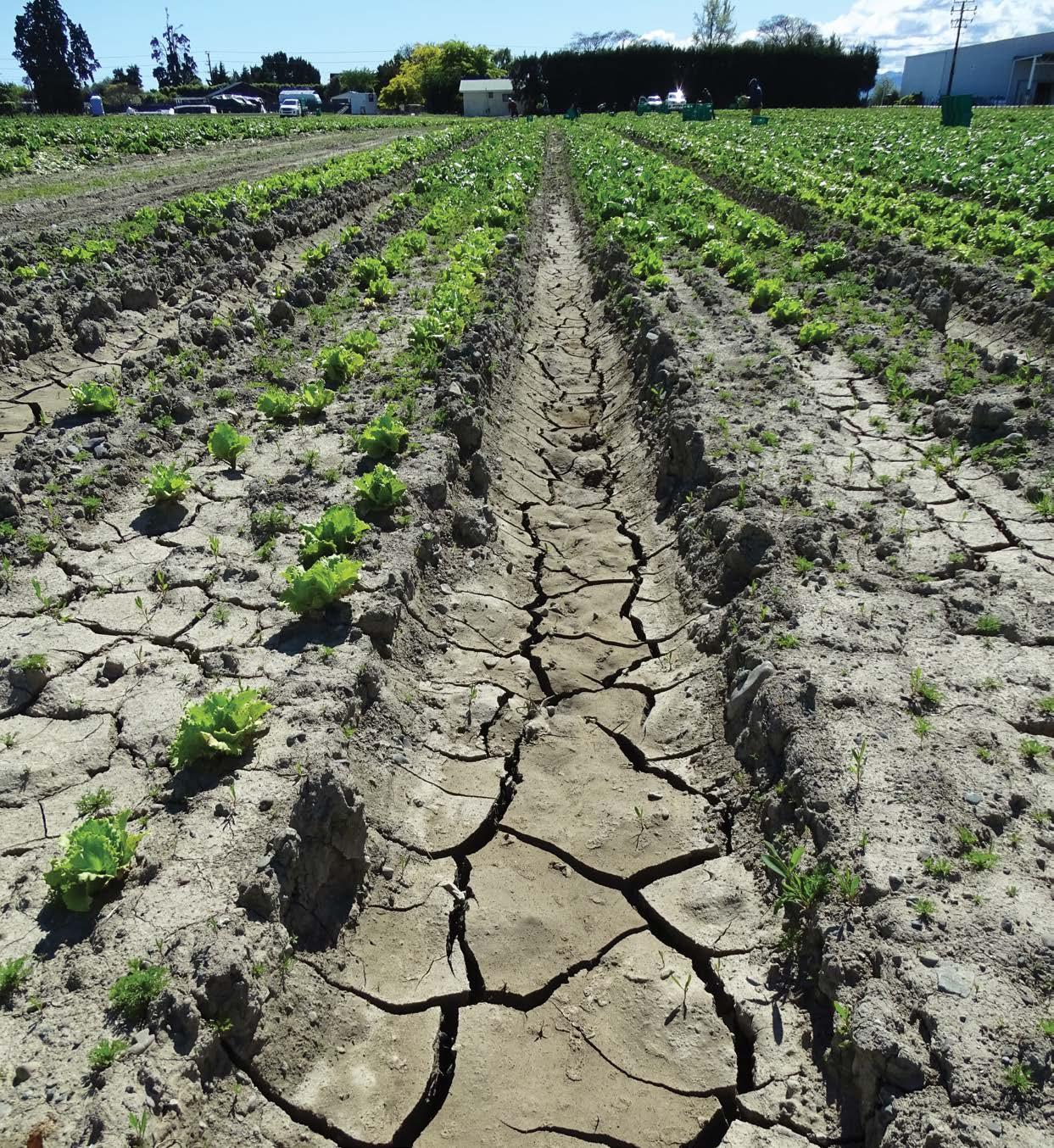
In our last update, we talked about the parts of Aotearoa New Zealand that had experienced record wet weather in the first half of 2023, driven in part by three years of La Niña. Now, just a couple of months later, the climate pendulum has swung all the way to an intensifying El Niño, with strength that may rival historically strong events that were associated with severe droughts.
Spring outlook: September to November
Conditions needed to officially classify El Niño were reached during September. Air pressure is forecast to be above normal to the northwest of Aotearoa New Zealand and below normal to the south, leading to more southwesterly quarter winds than normal across the country.
Spring rainfall is about equally likely to be near normal or above normal in the west of the South Island, and most likely to be below normal in all other regions. Spring may be marked by unusually long dry spells for several regions, owing to a combination of high pressure near the country and lower chances for atmospheric rivers.
Spring temperatures are most likely to be near average in the north and west of the North Island, and about equally likely to be near average or above average in all other regions. Spring will come with more southwest winds and occasional outbreaks of cold air as well as episodes of warm-to-hot air from Australia, particularly in eastern areas of both islands.
A prevailing area of high pressure near the North Island may lead to clear, cold nights and mornings and the potential for unseasonable frosts. Seasonal wind strength is expected to be above normal, particularly when westerlies intensify, as predicted from the second half of September.
Coastal sea surface temperatures (SSTs) ranged from 0.1˚ C below average to 1.1˚ C above average during August. As El Niño becomes firmly entrenched in the climate system, the risk for the development of widespread marine heatwave conditions during spring is low.
Soil moisture is most likely to be below normal in the north and east of the North Island, near normal in the South Island, and near or below normal in the west of the North Island. River flows are most likely to be near normal in the west of the South Island and near or below normal for all remaining regions of the country.


Probabilistic Precipitation Tercile Forecast
December 2023 – February 2024
This image shows the regions of the country that have at least a 40 percent chance of below normal rainfall over summer. It includes much of the North Island and parts of the northern and eastern South Island


El Niño is intensifying and signs are pointing to its strength possibly rivalling historically strong events. Previously, El Niño has been associated with some of New Zealand’s most severe, long-lasting and costly droughts. In addition, a positive Indian Ocean Dipole is rapidly developing; this was associated with the 2019–2020 drought, and is expected to reduce the risk for atmospheric rivers.
Strong westerly winds are expected to be a theme in spring, summer and possibly autumn.



NIWA and the Ministry for Primary Industries (MPI) are working together to develop a new drought forecasting tool. Recently launched, it uses innovative climate modelling, the latest in machine learning and other data-driven techniques. It is intended to help farmers and growers better prepare for periods of dryness and drought.

The tool updates daily to provide forecasts at a much higher spatial resolution than previously available. You can look at the country as a whole or drill down into district-level predictions of dryness and drought. Check it out at https://shiny.niwa.co.nz/drought-forecast/
Scan the QR code or go to www.niwa.co.nz/el-nino.


Areas of below normal soil moisture were developing in eastern parts of both islands. With westerlies expected to blow stronger than usual in the coming months,conditions are expected to dry quickly. There is a long-term dryness risk for Northland, Auckland, Waikato, Coromandel, Bay of Plenty, Gisborne, Hawke’s Bay, Wellington, Wairarapa, Tasman, Nelson, Marlborough, Canterbury, northern Otago. This also brings increased fire weather risk.
Keeping track of forecast and outlook updates will be very important in the months ahead.
Predictions of temperature, rainfall, soil moisture and river flows.
niwa.co.nz/outlook

The intensive field experiments run by Plant & Food Research (PFR) in Workstream 1 have all been completed. Analysis of this data is underway, with results being used to inform the model parameters underpinning the SVS tool. Key parameters include crop growth, harvest index, yield, crop N uptake and N partitioning by crop parts.
Regional monitoring in Workstream 2 will continue until the end of 2023, though crops growing through summer will be tracked through to harvest in 2024. Soil test and plant biomass data have been compiled in a shared database and are being analysed by PFR. Regional monitors continue to meet every month, where discussions on sampling protocols and issues encountered are evolving into a practice guideline for growers aiming to increase their own soil sampling.
Development of the initial farmer facing tool in Workstream 3 is nearing completion, with an early access version soon to be selectively released across the industry for testing. The user interface has been completed by Rezare Systems, with the API and web-app online. Concurrently, the underlying APSIM-SCRUM based model is being fitted to the results coming from Workstreams 1 and 2. A drainage submodel is currently being incorporated, which is a necessary component in calculating N losses and therefore the overall N balance.
Workstream 4 dissemination work continues prior to distribution of the tool. Dissemination and extension work has included: eight regional case studies, a stand at the Horticulture Conference and Potatoes NZ conference, presentations in Levin and Pukekohe, and monthly SVS articles on relevant topics. The SVS Technical Panel continues to meet once a fortnight and discusses a range of topics, bringing together researchers, agronomists, and growers.
Data from the four trial rotations in Canterbury and Hawke’s Bay have been collated and are being analysed. The Sustainable Vegetable Systems (SVS) model has to incorporate algorithms for soil drainage. Drainage calculations are a necessary step for integrating crop growth and nitrogen uptake with nitrogen losses to

For all your Horticulture needs
Foliar NUTRITION
• Enhance colour in foliage
• Increases brix levels
• Aids resistance to pests & disease
• Easy to use
estimate the nitrogen balance, a key component of the tool. Drainage calculations have been completed for both rotations of Workstream 1 trials. Drainage varies dramatically, dependent on time of year, the crop in the ground, rainfall, and irrigation treatment. Drainage rates for individual crops in Rotation 1 varied from just 11mm to 723mm. When combined with the nitrogen
Ocean NUTRITION

• Increases root mass & length
• Unlocks trace elements & micronutrients in soil
• Improves soil structure & water-holding ability
• Increases soil microbial activity

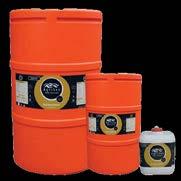

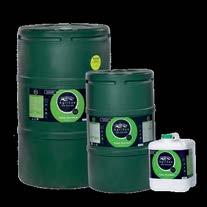

• Easy to use
• Deeper humus layer
• More natural nitrogen fixation
• Assists plant nutrient uptake

• Certified organic Nitrogen, Potassium, & Phosphorus source, 100% natural.
Improved soil structure
treatment applied, as well as the soil background supply of nitrogen, this can result in significant differences in the potential quantity of nitrate leaching. This underscores the importance of understanding key risk factors for nitrate leaching, regularly testing the soil for mineral nitrogen, and developing nitrogen balances for each crop – all challenges for growers that the SVS tool is designed to assist.

In the regional monitoring programme, the extremely wet conditions in the North Island have led to sampling challenges for regional monitors, and have forced adaptation to the challenging soil conditions – especially on the waterlogged clay soil around Pukekohe. Regular discussion between monitors, and the diversity in soil types and environmental conditions across the country over the past three years have led to a general increase in experience in taking soil tests. This will be recorded in a best practice guideline to assist growers with taking soil samples quickly and effectively, with the most suitable equipment for their soil environment.
The APSIM (Agricultural Production Systems Simulator) SCRUM (Simple Crop Uptake Resource Model) predicts crop nitrogen (N) uptake and use, and estimates N fertiliser requirement. This model underlies the grower facing tool. Work in model design and development is continuing, with updates to the model informed by Workstream 1 trial data, and calibrated using data from Workstream 2 paddock monitoring.
Drainage calculations from Workstream 1 will be used to assist with the development of a robust drainage model. This will be the core of how the tool calculates potential leaching, which, while not the focus of the tool, is an important component in calculating a nitrogen balance. For instance, if high rainfall has drained away a recently applied nitrogen fertiliser application to below the root zone, the tool will be able to recalculate and recommend further nitrogen applications to ensure the crop continues to grow.
Rezare Systems has completed the user interface of the SVS tool. It is currently going through initial user testing by Plant & Food Research (PFR) and Agrilink, and will shortly be distributed as an early-access copy to a selection of growers and industry professionals for feedback.
A feedback log is being continuously updated, with testuser suggestions categorised as one of the following:
• Model updates: required improvements to the fundamental model ahead of public release in 2024.
• Tool updates: improvements to the User Interface (UI) of the web-app, which will be integrated by Rezare prior to public release.
• Further development: larger suggestions that will be worked on and incorporated in follow-up programmes to SVS after the tool’s public release (e.g., outside software integration, interactive nitrogen flow diagrams, incorporation of other nutrients).
The last point is indicative of the fact that the initial public version of the tool is a minimum viable product, with plans already under development to upgrade the user interface and increase its functionality.
Fairbanks newest basil variety. Fantastic shelf life showing less yellowing and breakdown vs other market standards. Medium sized glossy green leaves, light savoy texture and oval leaf shape. Intense flavour.

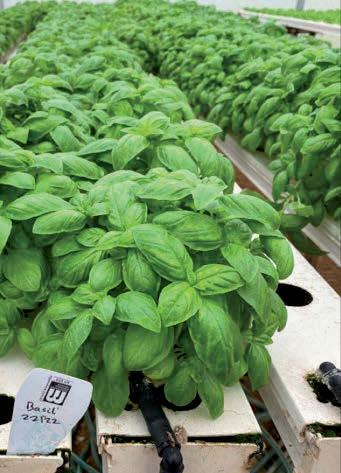
IR: Downy Mildew PB (DM-0).
Fairbanks seeds has been working hard on the development of two new Kabocha squash varieties.
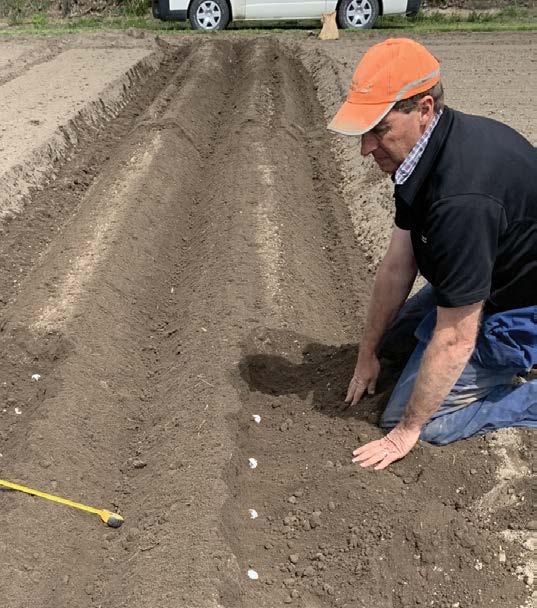


Ajiroman F1 “dry type” with dark green skin colour and vibrant orange internal colour.
Strong plant with good vine vigour and excellent fruit set.
Yumeroman F1 “Ebisu type” sweet nutty flavour with excellent fruit setting and strong plant.
Dark green skin colour with vibrant flesh.
Summer Spinach Variety with an extremely dark glossy green leaf being thick and durable.
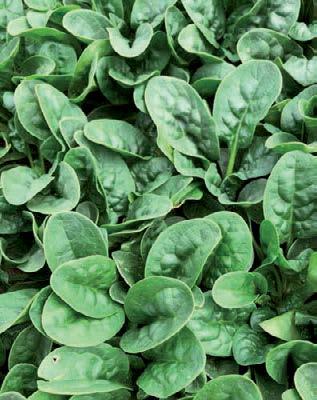
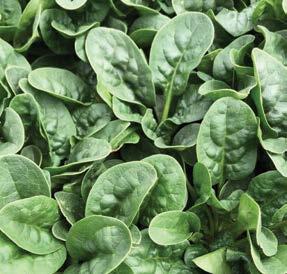
Exceptional holding noticed preand post-harvest. Outstanding summer performance to date.
HR: Pe: 1-7, 9-19/Sv.
AJIROMAN F1 - SQUASH YUMEROMAN F1 - SQUASH EL FURIO F1 - SPINACHAlongside the main web-app, Rezare has also developed an API (Application Programming Interface) and software development kit, allowing other programmes to integrate the SVS tool into their existing software, free of charge.
Upcoming developments
Tool testing and incorporation of trial results into the model is now the primary focus of the SVS programme. Upcoming work for the former includes distributing access to a selection of users from across the industry.
For the model development, PFR will continue to work on analysing the Workstream 1 data and calibrating the model. PFR will also work in partnership with Agrilink to analyse the regional monitoring data from Workstream 2 and ensure that the model has been ground-truthed to data from real-world operations across the country.



Further engagement with the industry is also being accelerated, with grower meetings and workshops planned based around use of the early access tool, and discussions with regional monitoring trial participants over their monitoring site data and results.


Fertiliser and other agronomy service companies will also be collaborated with, as these may become one of the primary end users of the SVS tool. It is hoped that the SVS tool will assist industry professionals with making nitrogen recommendations to growers. Meetings with these interested parties will be held over the next few months.

Likewise, engagement with the primary commercial soil testing laboratories will be undertaken to ensure that nitrogen soil test
results are clear and consistent. Consideration will be given to indicating results relevant to the SVS tool on soil test result forms, as current result formats have been found to be confusing, with inconsistent terminology and units between different laboratories.
In summary, over the next few months the SVS programme team will be engaging with a wide range of growers and industry professionals, ahead of public release of the SVS tool next year.
If you are interested in being involved in early access testing of the SVS tool, please email the programme manager Andrew Barber andrew@agrilink.co.nz.

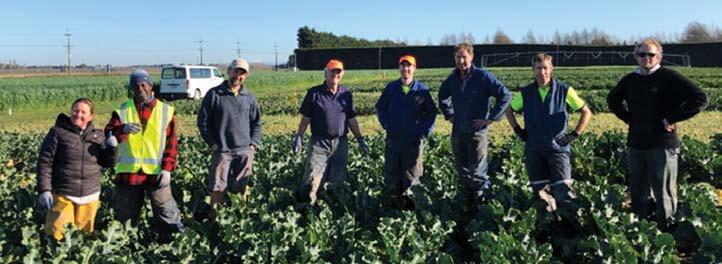
ALL THE LATEST NEWS FROM YOUR PRODUCT GROUPS

As you read this column, it will just be days before the
will be in full swing.
What’s struck me in the lead-up to the election is the across political party support for the growing of vegetables in this country.
The current Labour Government is to be applauded for ensuring that fruit and vegetable growing is recognised in legislation to replace the Resource Management Act (RMA). At the same time, while if elected, the National Party would repeal the RMA, it would introduce a National Environmental Standard (NES) for commercial fruit and vegetable production, so that growers will not need a resource consent to produce more food. The NES would also make crop rotation within catchments a permitted activity, and prevail over existing rules and consents, which should reduce red tape.

Our thanks to Horticulture New Zealand, in particular chief executive Nadine Tunley and strategy and policy general manager, Michelle Sands and her team, for all
the work they have done to put commercial vegetable growing fairly and squarely on the political agenda. The past month has been busy with direct interaction with growers and the wider vegetable industry on integrated pest management and our energy efficiency work, in conjunction with the Energy Efficiency and Conservation Authority (EECA).
We also welcomed Andrew Bristol to the team. Andrew comes to us from HortNZ, where he was communications manager for more than four years. For us, Andrew will play a key role in two-way communication between Vegetables NZ and you, liaison with district associations, engagement with industry stakeholders, and media relations.

One of Andrew’s first jobs is to make Vegetables NZ known to the new Grocery Commissioner, Pierre van Heerden and his team, as they come up to speed. Also, once any new government is formed, Andrew will oversee our first interactions with the new Ministers and their teams, and get them out of Wellington to meet some of you.

The Protected Cropping Australia (PCA) Conference was held in Brisbane from Monday 17 until Thursday 20 July at the Brisbane Convention & Exhibition Centre.


It was attended by 628 delegates, with 70 different exhibitors, and attendees from all over the world including 18 New Zealanders.
The format of the conference was really engaging, many of the speaker sessions (of three or four speakers) would finish with a panel for Q&A so the audience really got the chance to participate. Throughout the conference there were multiple panels of growers, researchers and industry experts which allowed for a wide range of information to be covered.
While all the content delivered over the course of the conference was interesting, there were a couple of standouts for me. One was the session with multiple speakers and workshops focused on Integrated Pest Management (IPM). While some of the insect issues faced by Australian protected cropping farmers are not applicable to New Zealand farmers, the concepts underlying IPM and many of the control strategies around key insects and diseases are very transferable. There is a lot of value in sharing information and expertise in this area for the mutual benefit of both industries.
Another interesting presentation was one by Dr Anne Sawyer from the University of Queensland who talked about RNA-based disease control in protected cropping environments. This is an emerging technology offering a potential for targeted control of insect pests, viruses and some diseases. While early days, this is already being investigated in New Zealand and could offer a new method of control for both protected crop and field crop growers.
Professor Paul Gauthier, University of Queensland, also gave an engaging presentation on ‘Future proofing food production in the APAC region through vertical farming
and protected cropping strategies’. He spoke of the increasing demand for food by the Asian markets and how protected cropping, in particular vertical farming, is well suited to meet this demand in an increasingly uncertain environment due to climate change. With temperatures rising and more adverse weather events, protected cropping offers more certainly around food production.
Matthew Plunkett, chair of PCA, provided feedback on the strong New Zealand representation, saying “PCA are proud to facilitate stronger partnerships with New Zealand based growers and industry. Bringing together growers and industry at the recent PCA Conference in Brisbane fosters sharing of knowledge, new technologies and innovations and strengthens relationships between our two countries.” PCA acknowledge the support of Vegetables NZ’s Daniel Sutton and Stefan Vogrincic from Grower2Grower for actively supporting NZ growers attendance. It is hoped that this collaboration will continue and PCA encourage our NZ friends to consider joining PCA
For myself, I wish to thank the Vegetables New Zealand Board for supporting my attendance at this conference, and Stefan Vogrincic from Grower2Grower who supported my registration. Stefan has been a great source of knowledge, good to share ideas with both during and after the conference.
 Daniel Sutton : Vegetables New Zealand Inc research, development & extension manager
Daniel Sutton : Vegetables New Zealand Inc research, development & extension manager


Potatoes have long been a staple crop in New Zealand, and our growers play a crucial role in ensuring a steady supply of this versatile and nutritious food source. However, there is a persistent threat that must not be underestimated: biosecurity pests and diseases.
These pests and diseases have the potential to cause significant damage to potato crops, leading to yield losses and economic hardships for our industry. To safeguard the potato sector, it is essential for all growers to remain vigilant and have a Biosecurity Plan and good strict hygiene practices. In this article, we emphasise the importance of these measures and encourage growers to protect the future of the potato industry.
The Biosecurity Plan is a framework that helps manage on farm biosecurity risks for all the potato industry. Implementing a farm biosecurity plan is the best way to ensure the risks are reduced, especially with the number of high-profile pest and disease introductions New Zealand has had in the last decade.
The plan will outline how you will manage your farm and how you will respond to a pest or disease outbreak. The plan covers the steps you take when moving machinery, tools and plant material on and off your property. How you trace and record any of these movements and manage risks that might be already present, and the steps you take if you see anything unusual.
Investing time into establishing good biosecurity practices on your property will ensure the continued smooth operation of day-to-day business and the avoidance of financial problems, movement restrictions and possible market access issues in the future.
Having a biosecurity plan is crucial during a biosecurity response.
There are six steps to preparing an on-farm biosecurity plan:
1. Review your property map(s).
2. Identify biosecurity risks and actions to address.
3. Prioritise those risks.
4. Communicate expectations to staff, contractors and visitors.
5. Implement your plan.
6. Review your plan annually.
Hygiene practices: A critical line of defence
Contractors should be given a comprehensive biosecurity introduction before entering your production sites, or have their own biosecurity plan. Ensure that they are aware of your mitigation measures, any machinery wash down and transport procedures, and any other biosecurity risk management requirements.
Prevention is the key to managing biosecurity risks effectively. Adopting good hygiene practices is crucial for minimising the risk of spread between fields and regions. Growers and contractors should be mindful of these practices:

Thoroughly clean all equipment, including machinery, tools and vehicles, before moving from one field to another. Contamination can inadvertently be transported on equipment.
Always use certified seed potatoes from reputable sources. Certified seed is screened and tested to ensure it is free from diseases and pests. Keep good traceability records that show where seed is used.
Practice crop rotation with non-host crops to break the life cycle of any potential contamination.
Ensure people visiting the property know your biosecurity requirements. Have parking areas, signin procedures, and clear communication of any biosecurity information required for your property.
Potatoes NZ held a workshop for growers with the latest insights on Potato Tuber Moth controlPukekohe grower breakfast meeting on Potato Tuber Moth and Early Blight control strategies
We are delighted to share that our recent breakfast meeting for growers in Pukekohe on 5 September was a resounding success, with a full turn-out. This event addressed critical topics such as Potato Tuber Moth and Alternaria (Early Blight) Control, providing essential insights and strategies for local potato growers. We extend our gratitude to all Pukekohe growers, agronomists, and industry professionals who attended and actively contributed to the discussions.

Conclusion
As custodians of our nationʼs potato industry, it is our responsibility to remain vigilant in the face of biosecurity threats. By implementing Biosecurity Plans, we can ensure the long-term sustainability and prosperity of our potato sector. By working collectively, we can safeguard the future of New Zealandʼs potato industry.
PNZ events provide a valuable platform for potato growers to connect with the PNZ team, agronomists and researchers, and access the latest research and advice tailored to your regionʼs specific needs. We encourage all growers, agronomists and industry professionals to mark these dates on your calendar. These events provide valuable insights and networking opportunities.
Pukekohe Grower Meeting
Date and Time: 26 October, 6:00 – 8:00 pm
Location: Ed Street Bar & Restaurant, 27 Edinburgh Street, Pukekohe
Focus: This meeting will delve into PNZʼs strategy discussion, and it is an opportunity to meet members of the PNZ board.
Central North Island Grower Meeting
Details are coming soon. Keep an eye on our events page at potatoesnz.co.nz
Canterbury Grower Meeting
Date and Time: 29 November, 6:00 – 8:00 pm
Location: Hotel Ashburton, 35/11 Racecourse Road, Ashburton
Focus: Join us for an engaging session centred around PNZʼs strategy discussion, and take the chance to meet our board members.
Early main season table potato, strong yellow flesh colour, firm cooking with great taste

NORTH ISLAND
Suresh Wallabh
M +64 21 153 3089
E suresh@eurogrow.co.nz
Tony Hendrikse
M +64 29 96 88 237
E tony@eurogrow.co.nz
SOUTH ISLAND
Elliott Crowley
M +64 27 380 3080
E elliott@eurogrow.co.nz


Growers gathered online and in person for this popular workshop on managing whitefly in greenhouse tomatoes using an integrated pest management (IPM) approach. Ahead of the prime season for whitefly infestation, Seth Laarakkers described the fundamentals of an IPM approach, and finished by sharing the progress of the TomatoesNZ and A Lighter Touch trials on new native predators which, in theory, should help keep whitefly under control while they hunt for psyllid.
The key points were:
• Scout well, preferably with a hand lens
• Introduce predators early and regularly
• Pay attention and help the predators if you need to.
If scouting occurs regularly and with equipment at sufficient resolution, and this is coupled with an understanding of what you are seeing, the effects of regularly introduced Encarsia controlling a whitefly population become evident. At this stage we can apply physical mode of action sprays to help the Encarsia keep up with whitefly numbers if required. Understanding the different temperatures that Encarsia survive at is important in determining your strategy. (A greenhouse should be at a minimum 24-hour average of 16 degrees Celsius.) Most people won’t be able to see whitefly eggs with the naked eye, although mature larvae, pupae and adults are easily recognised. That is why a scout with a hand lens is so important.
We explored a decision-making tree (available on the TomatoesNZ website) which described the course of action to take for three levels of infestation. This was followed by a discussion around the three levels of spray (physical, soft and hard) and why repeat applications are critical to success. There is no point in applying chemicals that impede your predator beneficials. Short term control often leads to long term problems.
For a better understanding of the hour-long presentation, please visit the TomatoesNZ website for resources from the workshop, the slideshow, an educational video and a decision tree matrix that will help you to get a better understanding. Please note that these have been developed specifically for tomato growers, but might transfer to other greenhouse crops. www.tomatoesnz. co.nz/hot-topics/whitefly-infestation-resources
For any questions on beneficial insects, please contact: www.bioforce.co.nz or email Dinah Cohen: info@tomatoesnz.co.nz

Keep an eye out for future workshops on other pests as more data is generated from the trials.
 Dinah Cohen : TomatoesNZ Inc business manager
Dinah Cohen : TomatoesNZ Inc business manager


It would be really helpful for future projects around energy to have an idea of the current set-up of your growing site – the age and materials used in the construction of your greenhouse(s), the energy you use and how much of the year you heat, other equipment that you already have, and so on.
Please take 5 minutes to complete this survey: forms.office.com/r/gn2W2s9Wcq





One of the funds that was talked about at the energy workshop was for hot water heat pumps. EECA is currently helping to fund the supply and installation costs of electric hot water heat pumps in greenhouses. These can be a cost effective and efficient means of heating without using fossilised fuel, but also without the need for a costly boiler, or adding storage space for the supply of fuel such as biomass, recycled oil etc.
Projects can be funded up to 50 percent with a maximum project cost of $150k. Please see www.eeca.govt.nz/co-funding/ industry-decarbonisation/ gidi-clean-tech/hot-water-heatpumps-programme for further information about applying for this funding.

For further information or feedback, email Dinah Cohen:
info@tomatoesnz.co.nz
 Julie North : vegetables.co.nz health & education manager
Julie North : vegetables.co.nz health & education manager

Vegetables.co.nz is proud to be a long-time supporter of the National Secondary School

Culinary Challenge (NSSCC) and this year we used this opportunity to celebrate the not-sohumble, and totally delicious, cauliflower.
Most of you are no doubt familiar with good old cauliflower in cheese sauce, and a fair few will have enjoyed the cauli-steak. But have you tried your cauliflower in a dumpling, as ravioli, custard, dried, creamed or caramelised? The eight teams from around the country who secured their place in the recent grand final certainly delivered outstanding creative entrée dishes showcasing New Zealand grown cauliflower.
The teams worked conscientiously in the hot and busy kitchen at the Manukau Institute of Technology in Ōtara to plate up their entrée dishes, and were well underway on their main plates when… the gas supply cut out. Any hope of a quick fix soon evaporated, and the
contestants were advised that the challenge would now complete with a change to the judging criteria which would incorporate a Q&A (question and answer) session in place of plated mains.
For teams who had worked for months to practice and prepare their entries this would have been devastating, but to the credit of everyone, they took it in their stride. As the judges noted, it would be naive to think working in hospitality always goes smoothly! Dealing with curve balls like this is arguably, part of the fun.
It was the team from Wellington Trades Academy who took home the Champions trophy and fantastic prize package. Their winning entrée dish is pictured opposite – we could
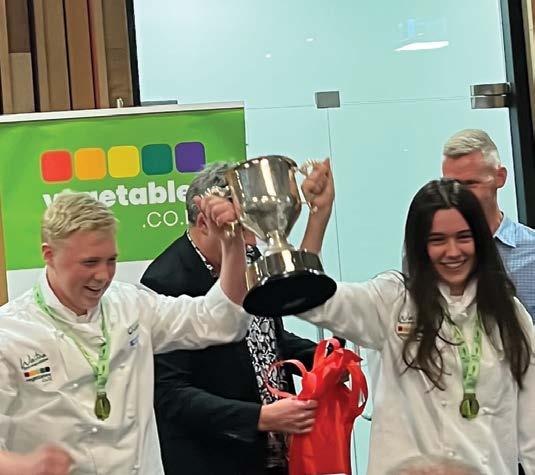
hear the tasting judges as they sampled this one and the plate was devoured as they tried hard to find any fault in the overall taste, texture and balance of flavours.

The following day we joined the group as their ‘ Culinary Journey’ kicked off with breakfast at the Bidfood distribution centre in Mangere. As a sponsor, we take the opportunity to give a presentation promoting our New Zealand vegetable industry and the importance of putting those vegetables on the plate. With many New Zealanders eating out, it is vital menus incorporate vegetables into dishes, not only mains, but entrées too. Not only standard menus, but kids’ menus too. Vegetables should hold pride of place in healthy and delicious meals.
The NSSCC remains an important opportunity for us to reinforce that message in the minds of the bright young stars who are entering the sector – our future chefs.
The eight final teams, representing their region were from:
Botany Downs Secondary School
Burnside High School
Kerikeri High School
Southland Boys’ High School
St Johnʼs College,
Taumarunui High School
Wellington Trades Academy
Whanganui High School
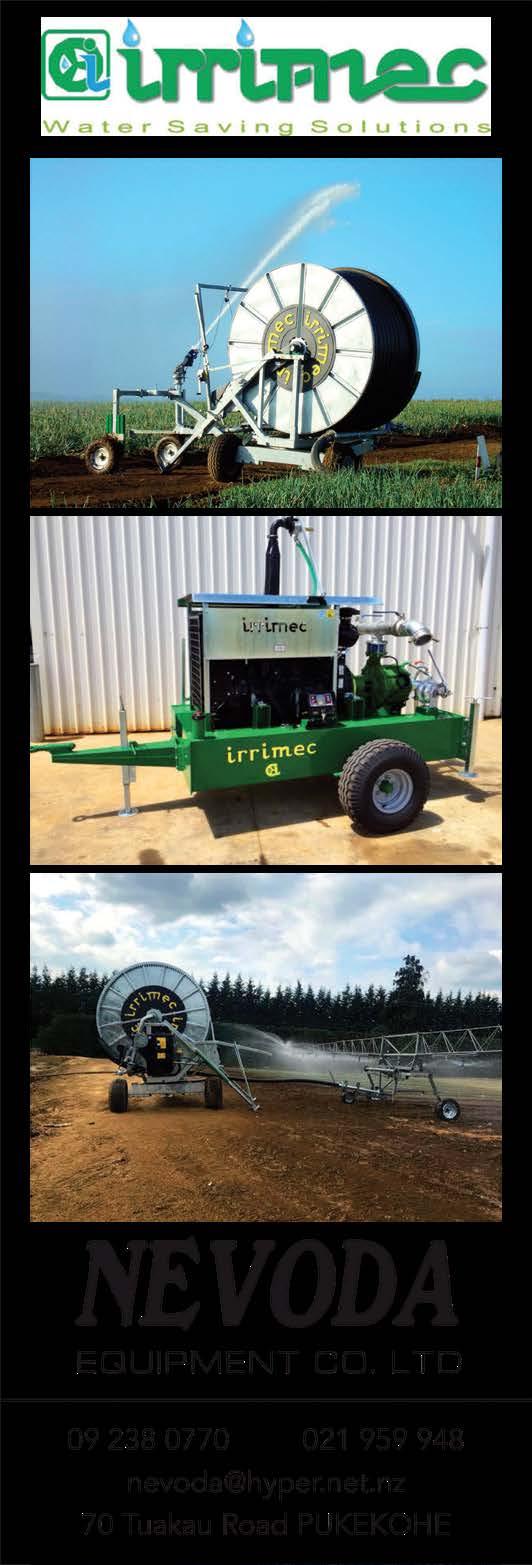 The winning cauliflower dish came from the talented Wellington Trades Academy team
The winning cauliflower dish came from the talented Wellington Trades Academy team
The Onions New Zealand team met many growers during a winter tour to gather feedback about how we are doing. Here we share the results and how we are acting on that feedback. Meanwhile, we have shared our priorities with all political parties and will focus on engaging with the next government, which is only days away.
Thank you to all those who attended the winter tour meetings and provided feedback to us on what we are doing well and what we can improve. Summary of the feedback:

• Overall: Relatively satisfied with our performance, but some refinements can be made.
• Biosecurity: Concern that Onions New Zealand is under-funding biosecurity, would like to see activity increased. Action taken: We have employed Anna Broxham to manage and improve biosecurity outcomes across onions, tomatoes and summerfruit. Anna is employed through HESL (Horticulture Executive Services Ltd) and cost shared across product groups.
• Research: Pukekohe wanting to see more investment in preventing and dealing with Stemphylium. South Island wanting to see investment in research that benefits South Island growers. Action: A document detailing the Stemphylium projects being undertaken is being developed and will be shared with industry soon. Workshop on 25 October in Pukekohe on Stemphylium International experts have been invited to New Zealand. South Island concerns still to be addressed.

•
Engagement: Need to improve our engagement with the industry, make sure our mailing lists are accurate and the way we send information to members. Looking at incremental improvements. Action: We are going to prepare short two-page reports on certain topics and dive deeper into them. E.g. Stemphylium, market access, SFFF (Sustainable Food & Fibre Futures) Humble to Hero, etc.
• Market access: Members satisfied with performance and want to see Onions New Zealand maintain this level of activity. Action: Maintaining activity. Two visits to China this year, and another one to Indonesia. Onions New Zealand also meeting with Indonesian Foreign Minister in October when they visit New Zealand.
• Increase co-investment/ contestable fund projects in SFFF Humble to Hero. Action: Fund can be expanded if members put projects forward.
If you have other issues to raise, or feedback to provide on our performance, please do not hesitate to get in contact.
Now that China is re-opening to the world post-pandemic, we are increasing our activity to try and speed up the process to gain market access. I will be visiting China at the end of September, and then again with exporters in November. In China I will be meeting with importers, New Zealand government officials, the importers association, and growers.


We have prepared a greenhouse gas and gross margin calculator for members. It is in a spreadsheet format so members can refine it with their own data and take greenhouse gas measurements for different customers and compliance requirements. We welcome feedback to assist with refining the model.
For more information visit: https://www.onionsnz.com/

Onions New Zealand has launched its key issues and opportunities document for the political season. The key areas for Onions New Zealand are:
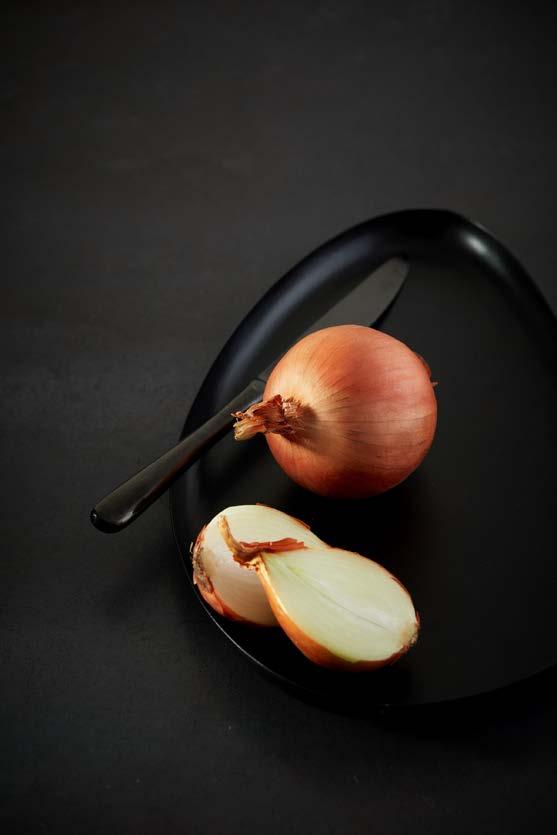

1. Improved market access to China, Indonesia, the European Union (on tariffs) and the Philippines.
2. Increased research funding and support.
When: 3.30pm, 25 October 2023, in Pukekohe following the Stemphylium workshop.
Venue: TBC
Reduce fertiliser costs and increase accuracy by placing fertiliser exactly where you need it!
This month we caught up with one of our produce clients running two FB-F Ferti-Box equipped tractors. Ferti-Box is a front mounted tank designed for targeted fertilisation.

Fieldco is owned and operated by the Simpkin family, located in the Kaipara region near Dargaville, ‘The Kumara Capital of New Zealand’. Their farms are situated in what is undoubtedly the best micro-climate for kumara growing in the country. The Simpkins have been supplying kumara since 1976. Their product range now includes fresh, processed, frozen, and kumara snacks, as well as potatoes and melons.
Fieldco bought their first FB-F Ferti-Box six years ago and, appreciating the benefits, followed up a year later with a second machine. Prior to the Ferti-Box, Fieldco had relied on ground-spreading contractors.

Jamie Doouss, Fieldco’s field crop manager, says that applying fertiliser themselves rather than relying on contractors means they have greater control of timing. That means they are better able to make use of favourable windows in the weather, which has been crucial over the last couple of years. The application accuracy of the Ferti-Box is also a big benefit, putting the right amount of product in the right place every time and with limited wastage.
Depending on the weather, the Fieldco crew use the Ferti-Box on a variety of the crops they grow, and usually
begin with a pre-plant base dressing. On some broadacre crops they have occasionally also used it for a mid-season secondary application.
Jamie says the Ferti-Box is an important tool in Fieldco’s toolbox. He says the attachment process is quick and simple thanks to the front three-point linkage. Fertiliser application is monitored through the tractor’s existing ISOBUS system, so there’s no need for an extra screen.
The big advantages, Jamie says, are the saving of time through the reduced number of passes and the accuracy of fertiliser placement. He says the occasional error is usually of the human variety.
Monitoring application through the Ferti-Box system and tractor movement via GPS (global positioning systems) gives Fieldco the information they need for compliance records.
As far as maintenance goes, Jamie points out that fertiliser is an abrasive corrosive product, so cleaning and maintenance by the operator are essential. The odd issue has been easily and quickly sorted by 4AG. He cites the 24/7 support as being a big plus.
Give 4AG a call to discuss how the Ferti-Box can add value to your operation 0800 424 100
Food producers face challenges across all sectors in New Zealand, and there is a common thread with almost all of them.
It is healthy soil.
Soil is a living, breathing ecosystem that feeds everything on the planet, it is our third largest carbon sink and underpins New Zealandʼs GDP (gross domestic product).
Growers are working towards healthier soil through initiatives like the Sustainable Vegetable Systems research programme. Orchardists, viticulturalists and vegetable growers are also sharing knowledge through A Lighter Touch.
What can be learned if we consider the mana and mauri of soil first and foremost in our production of food?
Rere Ki Uta, Rere Ki Tai is a pilot project helping farmers understand their connection with soil on multiple levels.
It is led by AgriSea, an intergenerational Māori agribusiness, as part of the Revitalise Te Taiao research programme funded by Our Land and Water (Toitū te Whenua, Toiora te Wai).

In farming, soils are readily described by their physical and chemical characteristics of ‘soil quality’ which is related to intended use.
Indicators such as Olsen phosphorus, total nitrogen and microporosity are familiar. However, the biological indicators – the mauri in the soils – are not monitored directly.
Through Rere Ki Uta, Rere Ki Tai farmers on ten diverse farms throughout the Waikato and Bay of Plenty have identified gains from altering their grazing techniques or herd numbers, creating plant diversity, reducing fertilisers and including circular coastal nutrients through rimurimu (seaweed) and fish waste which stimulate the biology of the soil.
Lincoln University’s Professor Pablo Gregorini and his team are collecting data on soil, pasture profiling and metabolome analysis from blood and rumen of lamb-ewe pairs fed on AgriSea biostimulants versus conventional treatments, and rye grass versus diverse pasture treatments.
The soil health profile and growth of the pasture are monitored for biological activity, carbon sequestration, soil fertility and nutrient availability, organic carbon, and hot-water extractable carbon.
The farmers are working alongside practitioners of western and Māori science, and have identified some of their practices to show respect for soil.
So what would a ‘mana and mauri’ approach to growing fruit and vegetables entail?
For Rere Ki Uta, Rere Ki Tai, a starting point was for researchers to respect the knowledge of the farmers which they inherited from their ancestors.
Mātauranga (Māori traditional scientific knowledge) is a key component of Rere Ki Uta, Rere Ki Tai. This includes the use of seaweed, and following the phases of the moon, which is captured in the maramataka work with our kairangahau, Erina Wehi-Barton.
Workshops on farms are an essential element.
The farmers are guided by a former organic dairy farmer, Nick Collins, and current practising dairy farmers Miah and Jenny Smith.
They are gaining a huge amount from visiting other farms that have faced the same challenges, and are further down the path of regenerative agriculture. They are empowered to question what they have been told if it hasn’t rung true for them on their land.
Challenges will differ for horticulture and agriculture. But taking a deeper dive into microbiology is uncovering benefits from an economic and wellbeing perspective and helping farmers to meet regulatory targets.
Follow the project at:
https://ourlandandwater.nz/project/revitalise-te-taiao/ LinkedIn:
https://www.linkedin.com/company/82774085
The need for seasonal cooling is one of the most common reasons why companies rent chillers, rather than make a costly capital investment.
If you are only going to be using equipment for half the year or less, why pay for a machine that’s redundant for the rest of the year?
And more often than not, it’s a pretty basic requirement: Summers are hot and we need to keep our harvested crops and products cool!
Trane has over 100 years of expertise in the cooling business, so if you require temperatures of between –12°C and 20°C, Trane will have a rental solution for you. For short-term rental of between one month and 36 months, our standard rental option will meet your needs. For a longer-term rental of between 36 months and 108 months, then our EaaSy rental solution may be best for you. With EaaSy, you pay the full rental rate when you are using the machine, and a reduced rate when you’re not.
In both cases, the costs associated with owning a unit are eliminated, as Trane covers all parts, servicing and maintenance. We also remotely monitor the operation of the machine, so we can quickly resolve any problems that may occur.
Benefits of a Trane Rental:

1. High quality European built Trane chillers
2. Correct sizing of the chiller to suit your needs
3. Quick delivery of the chiller and any required accessories
4. On-site commissioning by one of our factory trained experts
5. Remote monitoring of the chiller for the whole of the rental period
6. Comprehensive on-site maintenance (if the rental period is for three months or more), covering all parts and labour
7. Free swap out of the chiller if you require a larger capacity unit (available on EaaSy Rental) –some conditions apply.
Alternatively, if you wish to buy your own unit, we have the system that will be right for you.
At Trane we have an air-cooled or water-cooled chiller for all your needs, be it a rental solution, or the supply of your own machine to purchase.

Simply call 0800 1 Trane.

Key Contact Details
Rentals
Gary Morris
National Service Sales Manager
Mobile: 0272 836 949
Email: gary.morris@tranetechnologies.com
New Sales
Martin Tucker
National Business Development Manager
Mobile: 0276 243 254
Email: martin.tucker@tranetechnologies.com
Over the last 30 years, Powerplants has moved from strength to strength to become a premier Greenhouse Technology provider in Australia & New Zealand, utilising leading horticultural expertise & local manufacturing to help growers improve commercial outcomes & sustainable productivity.


We’re looking for a New Zealand Technician with strong customer management skills to join the team & help establish local support for growers.
The ideal candidate excels in a customer-facing role, has strong interpersonal/IT skills, is committed to exceptional customer service, & has established knowledge of electrical, hydraulic, & mechanical systems.
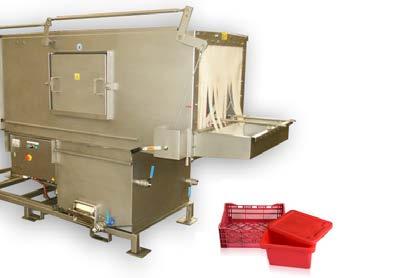
This is a role with opportunities for developing project management & sales skills, as well as travel prospects covering significant horticultural hubs within New Zealand.
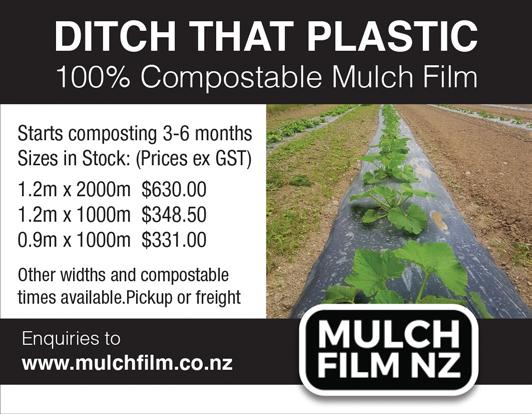
Horticulture New Zealand is co-funding a project with the ACC (Accident Compensation Corporation) through their Workplace Injury Prevention Grant to better understand causes of harm in horticulture and viticulture.


If you don’t understand the problem, you can’t fix it. ACC data from the wider agricultural sector tells us rates of harm have been increasing in horticulture. Each year, around $18 million is paid out in horticulture-related ACC claims. Their data shows lumbar sprains, cuts to hands and fingers, and injuries to the back, shoulder, and eye are the most common in horticulture. We also know there are high levels of stress.
We want to ensure Grow Home Safe is by industry, for industry. We know our growers are already doing great things to look after the health, safety and wellbeing of their teams, so we want to share the good work already happening and work with industry to develop new initiatives where there are gaps. Grow Home Safe aims to provide growers with horticulture-specific knowledge to inform their risk management and business decisions, and tools and initiatives to help keep their people safe.
To find out more, visit: www.growhomesafe.co.nz or email: info@growhomesafe.co.nz
We are partnering with Site Safe to develop foundation level health and safety training. By having industry standard training, employers can be confident that workers will have a base level of health and safety knowledge, making induction easier and ensuring a safer workforce. We have started developing this training with an industryled steering group set up to ensure the training is fit-forpurpose and meets industry needs.
We have worked with health and safety specialists IMPAC to develop horticulture-specific risk management training. Feedback from the pilot sessions show that growers love that the imagery, language and examples were all tailored to hort. It made sense to them, and they could see how to apply the concepts back on orchard and in the field. In October and November this is being rolled out as nine user-pays workshops in weather-affected regions of the North Island. See the website or contact us for details.
Branded Grow Home Safe, the project is one of the initiatives run through Rebecca Fisher’s team at HortNZ.Rebecca Fisher : HortNZ general manager projects & programmes Horticulture New Zealand HortNZ advocates for and represents the interests of New Zealand’s 4,200 commercial fruit and vegetable growers. HortNZ’s purpose is creating an enduring environment where growers thrive. HortNZ has 20 affiliated product groups and more than 30 affiliated local and regional grower associations. Find out more on www.hortnz.co.nz
Frontline managers and growing operation owners register now for this health and safety workshop
Learn how to proactively identify and control risks. This workshop will focus on managing risks following severe weather events and related hazards.
Workshop outcomes:
Understand the legal requirements for risk assessment
Define the key terms including hazard, harm, risk (including critical risks) and controls
Developed in response to research undertaken by the Grow Home Safe project, we have partnered with health and safety specialists at +IMPAC to provide horticultural training sessions to help reduce harm in the sector.

This workshop helps growers meet their legal duties under the Health and Safety at Work Act 2015, meet GAP requirements and provide useful tools and knowledge that can be utilised to create safe systems of work for their teams.
Apply three specific tools to identify hazards
Get help with meeting GAP health and safety requirements
Explain the steps within the risk assessment process
Understand what a safe system of work is, and its importance.
Workshops are being held in weather affected regions in the North Island.
To find out more about this workshop including locations, dates and times go to www.growhomesafe.co.nz.
To register email info@growhomesafe.co.nz
Through the support of the Ministry for Primary Industries (MPI) and its North Island Weather Events fund, tickets are at a subsidised cost of $75+GST per person. Each workshop is limited to 16 people (only one person per growing operation can attend).
Don’t miss this invaluable opportunity to enhance your risk management skills and ensure the safety of you and your team.






